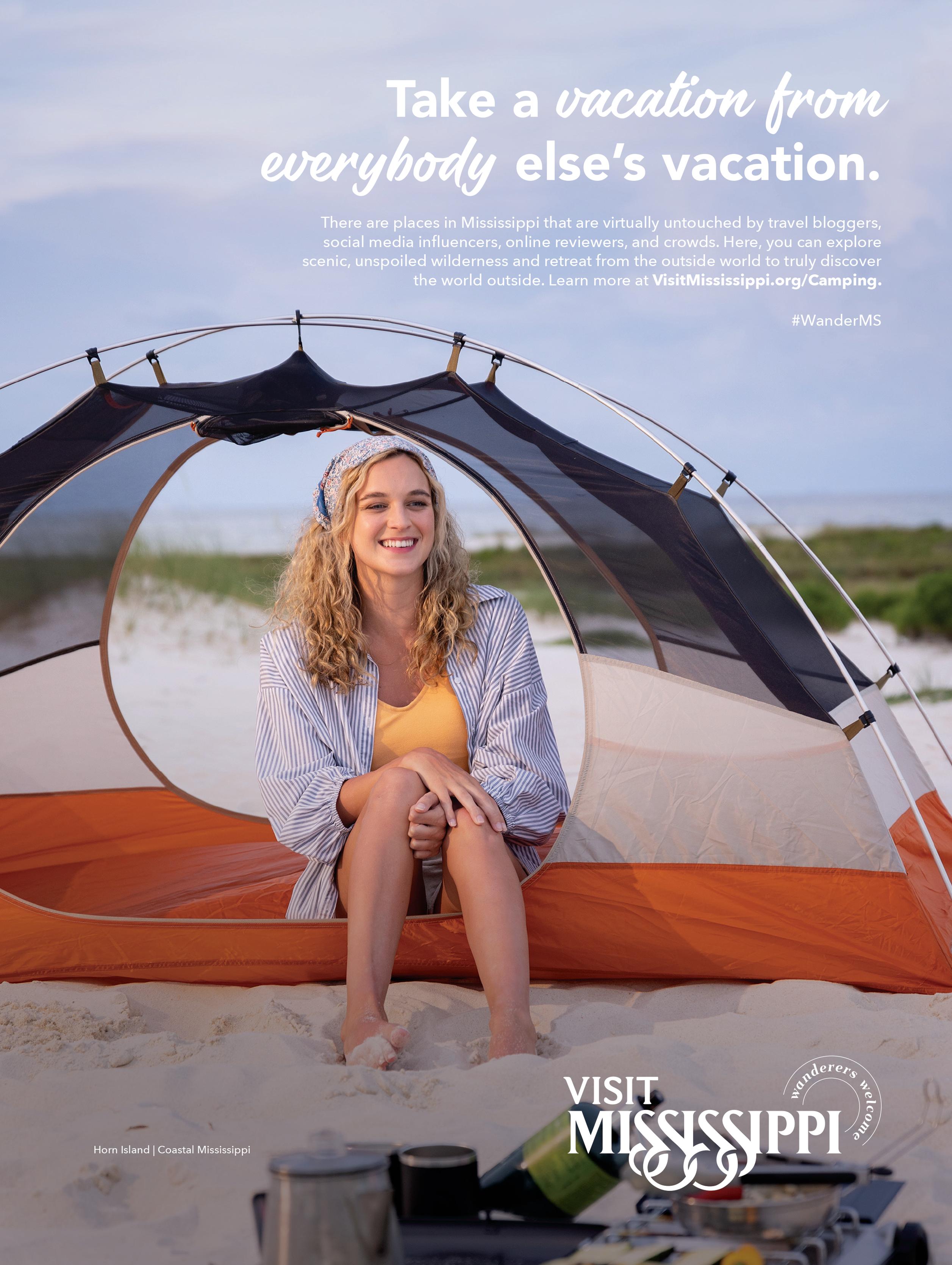the Louisianian’s field guide
THINGS EVERY LOUISIANIAN SHOULD KNOW AND PLACES EVERY LOUISIANIAN SHOULD GO





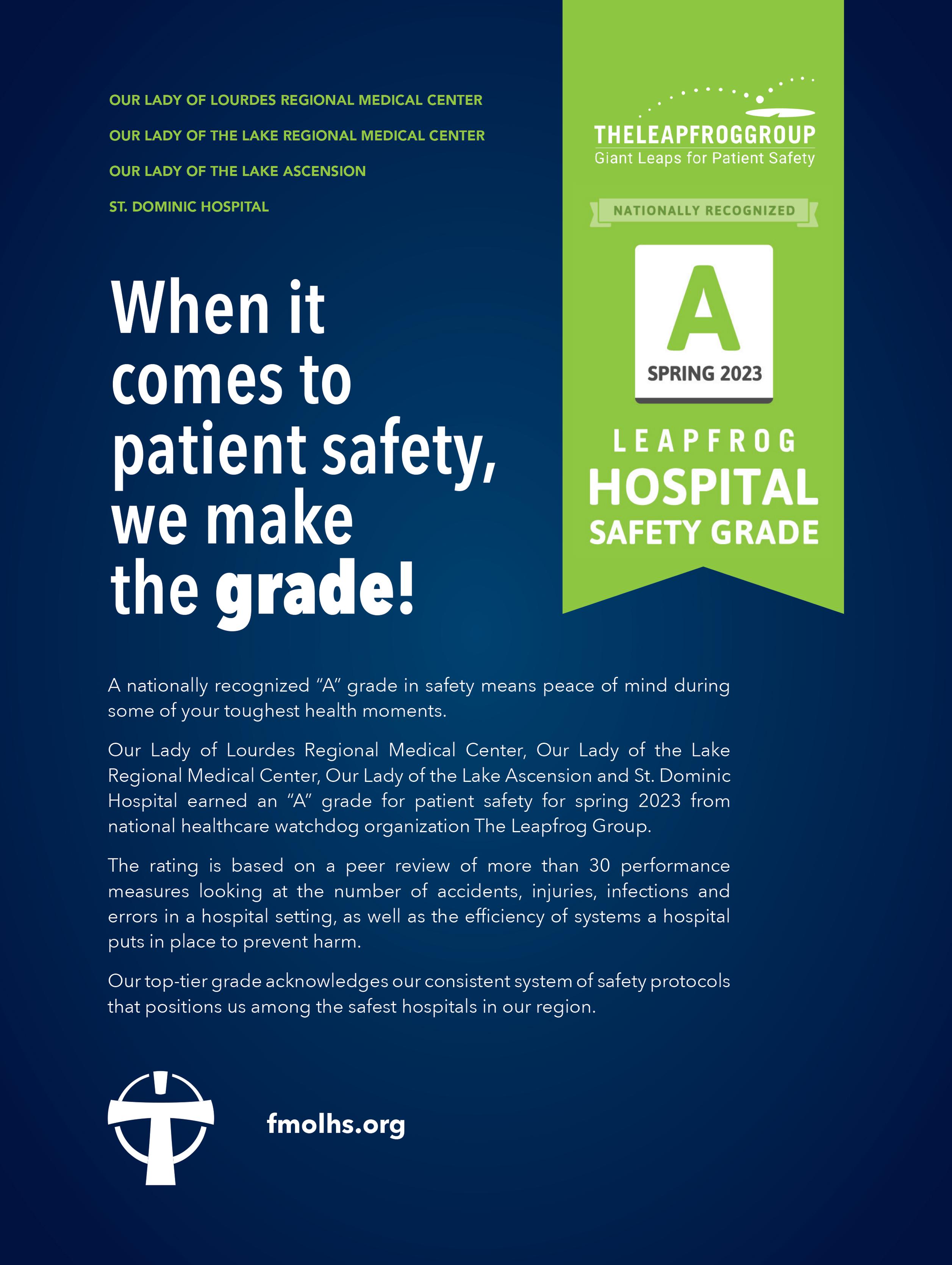



THINGS EVERY LOUISIANIAN SHOULD KNOW AND PLACES EVERY LOUISIANIAN SHOULD GO








ON THE COVER: Our splashy crawfishinfused cover for this issue was shot by Theresa King and the model is Britney Werner Lee.
20 MADE IN LOUISIANA Therapy Skateboards rolls out of Hammond
24 ART
New Orleans artist Hannah Chalew uses her work as a tool for change

28 HOME
Artist and collector Andrew Lamar Hopkins’ passion for antiques and art is on display in his French Quarter abode in New Orleans
32 KITCHEN GOURMET
Blue crab is a summer staple in Louisiana and is as versatile as it is delicious

56 NATURAL STATE
Rip Van Winkle Gardens in New Iberia marries history, preservation and conservation
60 TRAVELER
Toledo Bend’s list of attractions grows beyond its reputation for fishing, boating and golfing
62 FARTHER FLUNG
Tennessee’s Gatlinburg and Pigeon Forge
take you higher, naturally
64 PHOTO CONTEST
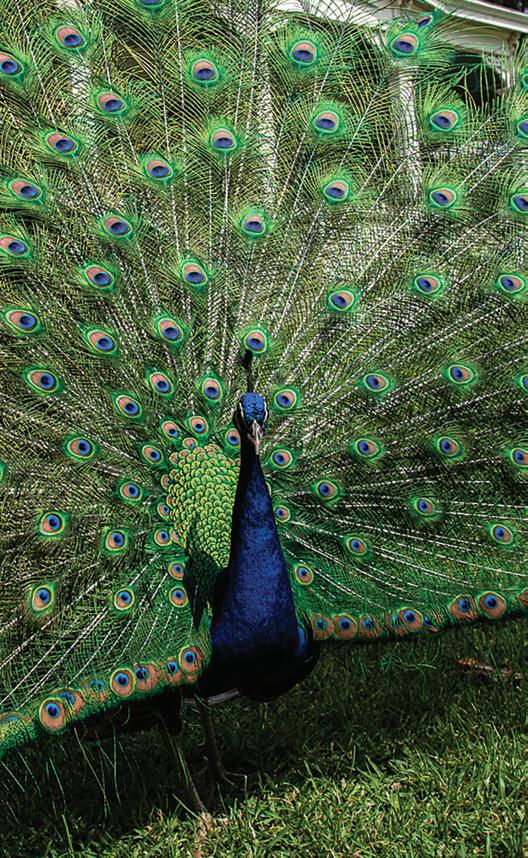
A brown pelican perches on the rocks at Holly Beach in Cameron Parish
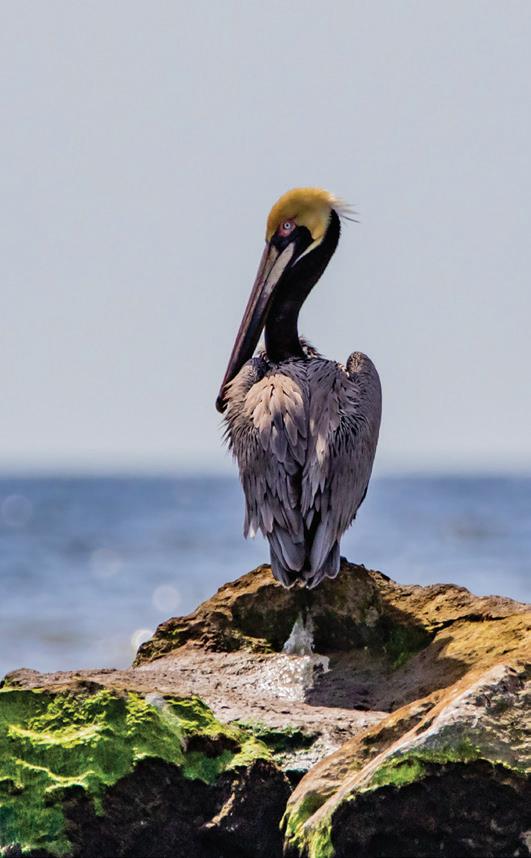

As the editor of Louisiana Life Magazine, I probably shouldn’t admit this, but until about 12 years ago I avoided eating crawfish.
As I’ve shared before, I wasn’t an adventuresome eater in childhood. Also, I grew up in Kentucky, not Louisiana and — spoiler alert — the Bluegrass State is not known for its seafood. As I moved closer and closer to the Gulf Coast however, I was introduced to crawfish boils. It still took many years of watching everyone else gobble them down for me to warm up to trying one. Once I finally got over my squeamishness however, I was sold and have been bellying up to the boil with zeal ever since.
I’ll never get back the years I deprived myself of fresh, hot crawfish, but I’ll do my best to make up for it. Thankfully when you live in Louisiana, opportunities to eat crawfish are plentiful, even in the off season. Not that I’d do such a thing, but to each their own.
Speaking of preferences and pastimes, our JulyAugust issue has become one in which we explore a certain hobby or interest and create a travel guide around it. For example, we’ve done a Craft Beer Lovers Guide to Louisiana, the Birders Guide and, last year, the Literary Lovers Guide to Louisiana.
This year, we’re doing something new with the guide. We’ve created a list of things every Louisianian should know and places every Louisianian should go. Behind the scenes we dubbed it the Louisianian’s Field Guide and the name stuck.
While it would be impossible to include everything a Louisianian could, should or might get up to in a lifetime, we’ve honed in on the essentials. It was entertaining to pull this together and it’s already a resource when I’m looking for something fun to do or a new place to visit. I hope it becomes the same for you. Email me if there’s a skill, place or something else important we left off. Who knows, maybe we’ll have enough to make a sequel?
Meanwhile, I’m working my way through anything on the list I haven’t already done. Join me, won’t you? Tag us on social media with the hashtags #louisianalife or #louisianiansfieldguide as you check things off, so we can all follow along.
EDITORIAL
EDITOR Melanie Warner Spencer
ASSOCIATE EDITOR Ashley McLellan
COPY EDITOR Liz Clearman
WEB EDITOR Kelly Massicot
FOOD EDITOR Stanley Dry
HOME EDITOR Lee Cutrone

EXECUTIVE EDITOR Errol Laborde
ART DIRECTOR Sarah George
LEAD PHOTOGRAPHER Danley Romero
FOOD PHOTOGRAPHER Eugenia Uhl
HOME PHOTOGRAPHERS Sara Essex Bradley, Haylei Smith and Marc Gibson
SALES
SALES MANAGER Rebecca Taylor (337) 298-4424 / (337) 235-7919 Ext. 7230
Rebecca@LouisianaLife.com
RENAISSANCE PUBLISHING
PRODUCTION
PRODUCTION MANAGER Rosa Balaguer Arostegui
SENIOR DESIGNER Meghan Rooney
PRODUCTION DESIGNER Ashley Pemberton
CIRCULATION
SUBSCRIPTIONS Jessica Armand
DISTRIBUTION John Holzer
ADMINISTRATION
OFFICE MANAGER Mallary Wolfe
CHIEF EXECUTIVE OFFICER Todd Matherne
For subscriptions call 877-221-3512
MELANIE WARNER SPENCER EDITOR MELANIE@LOUISIANALIFE.COM110 Veterans Blvd., Suite 123 Metairie, LA 70005 (504) 828-1380
128 Demanade, Suite 104 Lafayette, LA 70503 (337) 235-7919 xt 7230
LouisianaLife.com
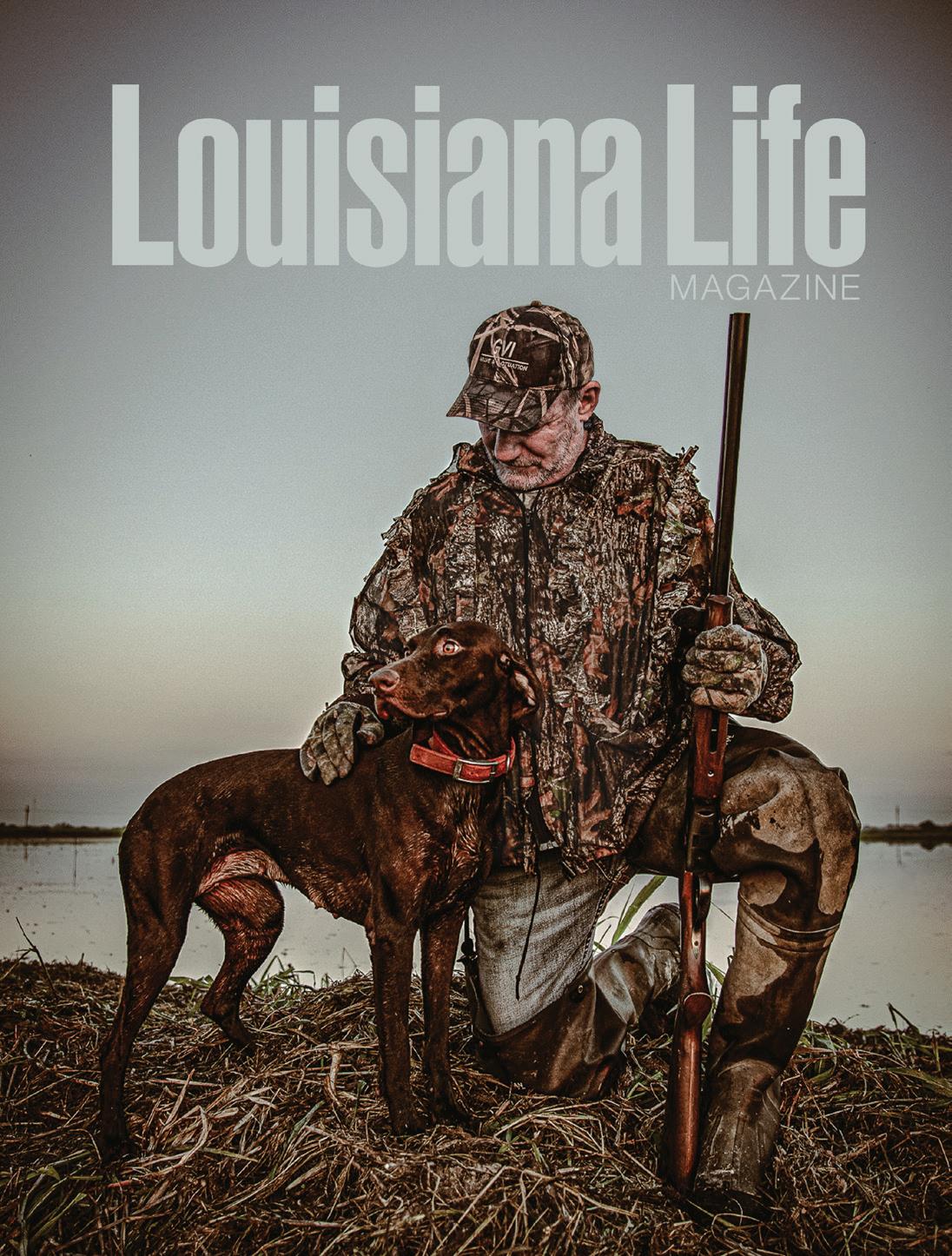




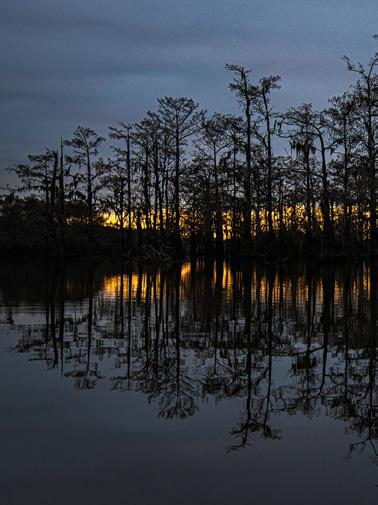
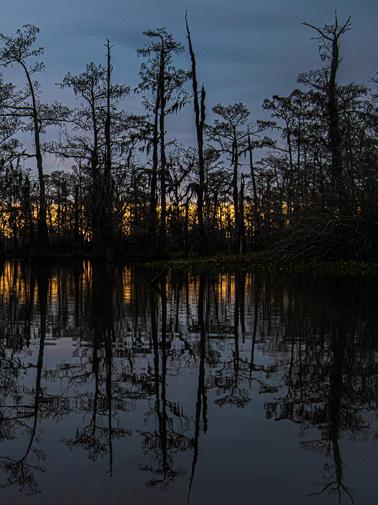

There is something about this magazine that we have not said much about; perhaps it was because of shyness or maybe uncertainty about the protocol of the media talking about itself. But then came the inner realization; first meekly but over time intensifying and finally exploding: Dammit, somebody has to say something and if we don’t do it, no one else will.
So here we are, having lost our cool but at least willing to shout our message: This publication, Louisiana Life Magazine, is one of the top “state and regional” periodicals on the continent. (That includes Canada where there are lots of regional magazines.)
We make this boast based on an authority for competitive evaluation of regional magazines, an organization called IRMA (the International and Regional Media Association). The group takes its annual journalism contest quite seriously as it searches each year for qualified judges. In 2019, at IRMA’S annual convention in Charlotte, North Carolina something happened for the first time ever. Judges use a very elaborate point system for determining the coveted annual Magazine of the Year award. In the highly competitive 35,000 or less circulation category, to the astonishment of the judges there was a tie for first: Louisiana Life and its sister publication Acadiana Profile. In 2022, at a conference in Ottawa, Canada, little sister Acadiana Profile won best publication all on its own. (Louisiana Life was close behind.) This year, in Portland, Oregon Louisiana Life received an award for being one of the finalists. Others included Kansas Magazine and Adirondack Life
If this was the NFL, we could say that in the last few seasons Louisiana Life has either won the Super Bowl or made it to the championship rounds.

Within the categories, the magazine has always scored high in art direction, features, covers (a very competitive category in which the magazine won Gold in 2022 for its cover of an alligator hunt). Oh, and since you asked, in Portland this column that you are reading won a Bronze award.
Podcasts are a growing subset of the industry and now just about every publication has one. Ours, “Louisiana Insider,” is relatively new but good enough to have nailed a Bronze award in Portland as well.
I could go on listing names of our gold-plated staff and contributors but then I would be vulnerable to a Dishonorable Mention for Omissions. We are proud of them all.
Because we are a regional magazine, we have a wider market to reach for bragging — and that can get costly. (In Louisiana, a relatively small state, there are seven TV markets alone.)
Instead, we are blowing our own horn. All that we ask of you is to look at what we have done and, if ever it is appropriate, to spread the word. Meanwhile, the most important story, we know, is not us but Louisiana, and we will continue trying to cover it even better than ever.
Monroe Doctrine with Mayor Friday Ellis
Friday Ellis, the first term mayor of Monroe, talks about his city and a vision of the state from his perspective, as well as that of other City Hall colleagues. Also hear about serious plans for AMTRAK rail service and downtown revival. Mayor Ellis’ wife Ashley also joins the conversation. The Monroe First Lady is a member of the Board of Elementary and Secondary Education. Guests: Friday and Ashley Ellis
Robert Mann, Huey Long and LSU
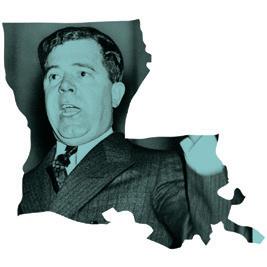
Robert Mann, an historian, author and a political consultant, talks about his book, “Kingfish U: Huey Long and LSU.” More than just telling the story about the evolution of a university, the book provides a fascinating study of the state and its politics. Guest: Robert Mann
 ERROL LABORDE EXECUTIVE EDITOR
ERROL LABORDE EXECUTIVE EDITOR


For a list of this magazine’s 2023 IRMA awards turn back to page 9 or visit louisianalife.com/louisiana-life-magazine-wins-2023-international-awards
Mike Matherne, whose family own one of the 25 perique tobacco farms, tells the story about the growth and fermentation of the plant. He talks about perique’s use as a flavorful condiment to mix with other tobaccos used in cigars and pipes. Guest: Mike Matherne

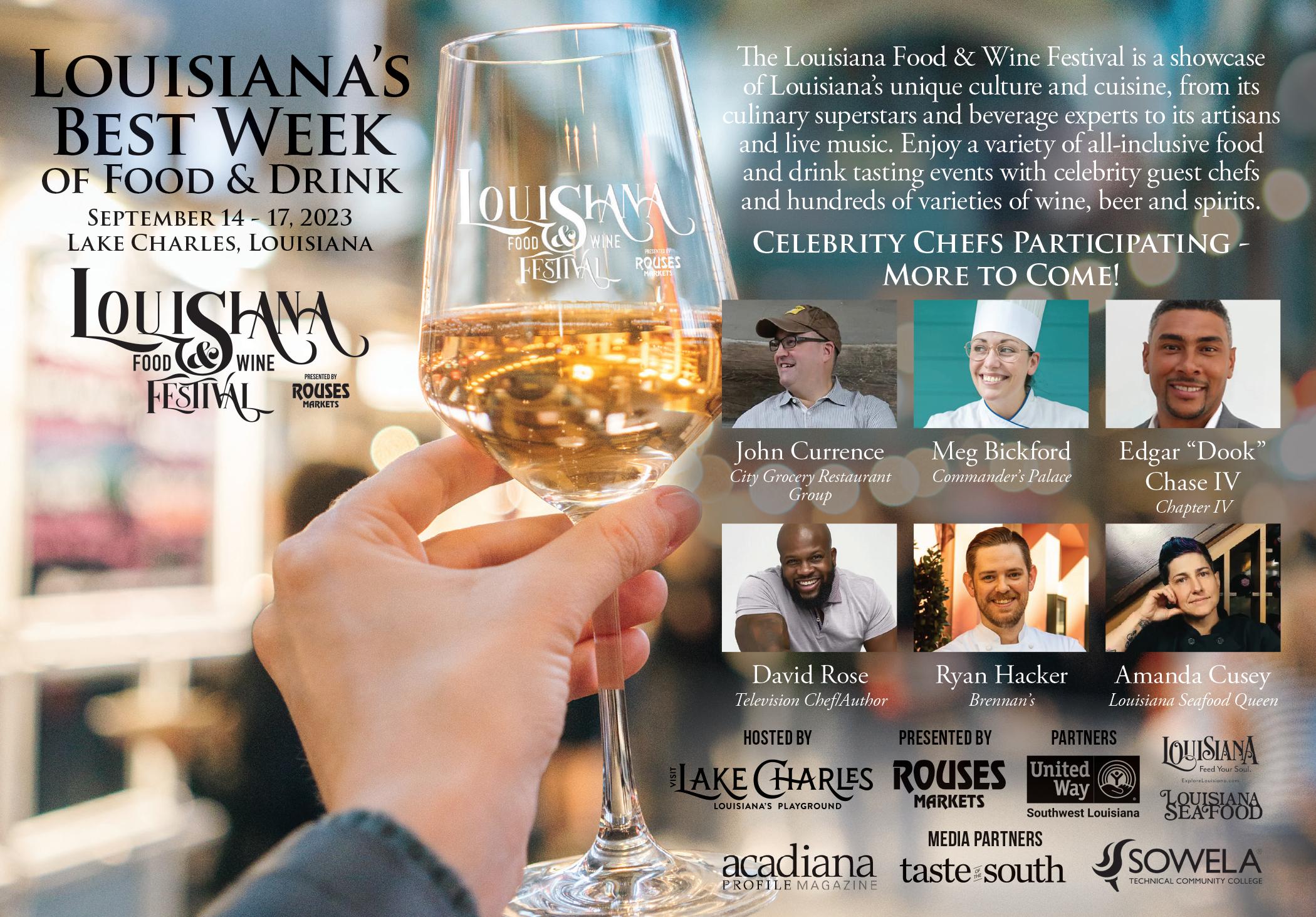
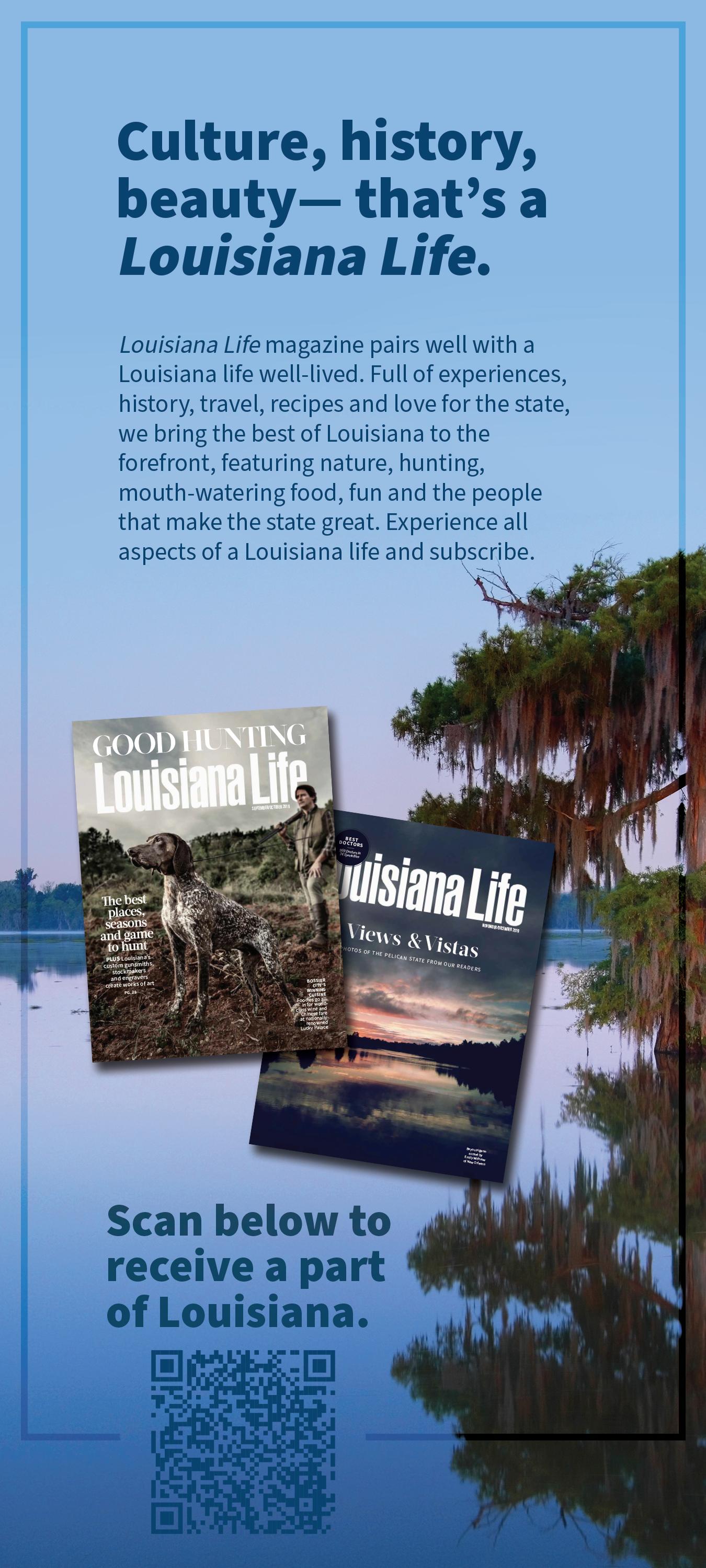

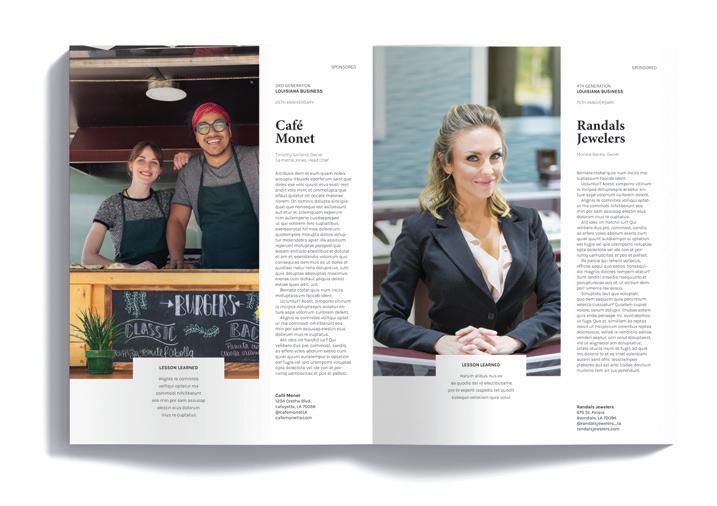
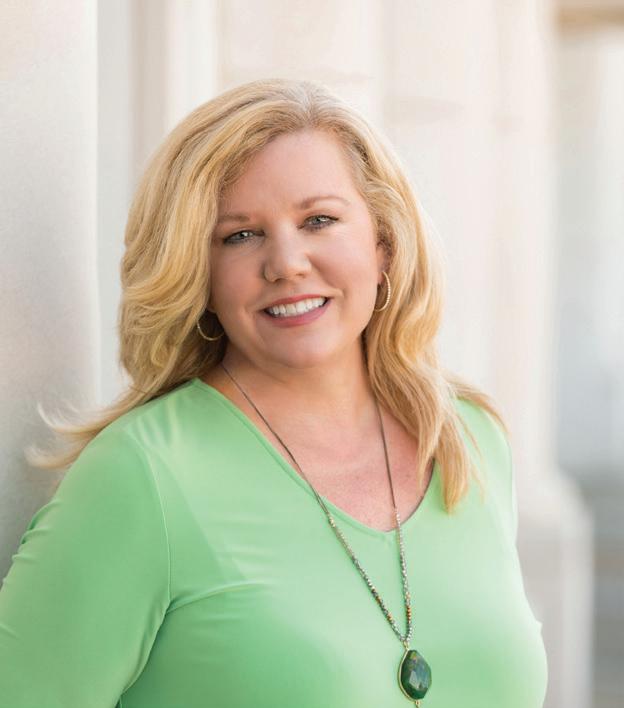


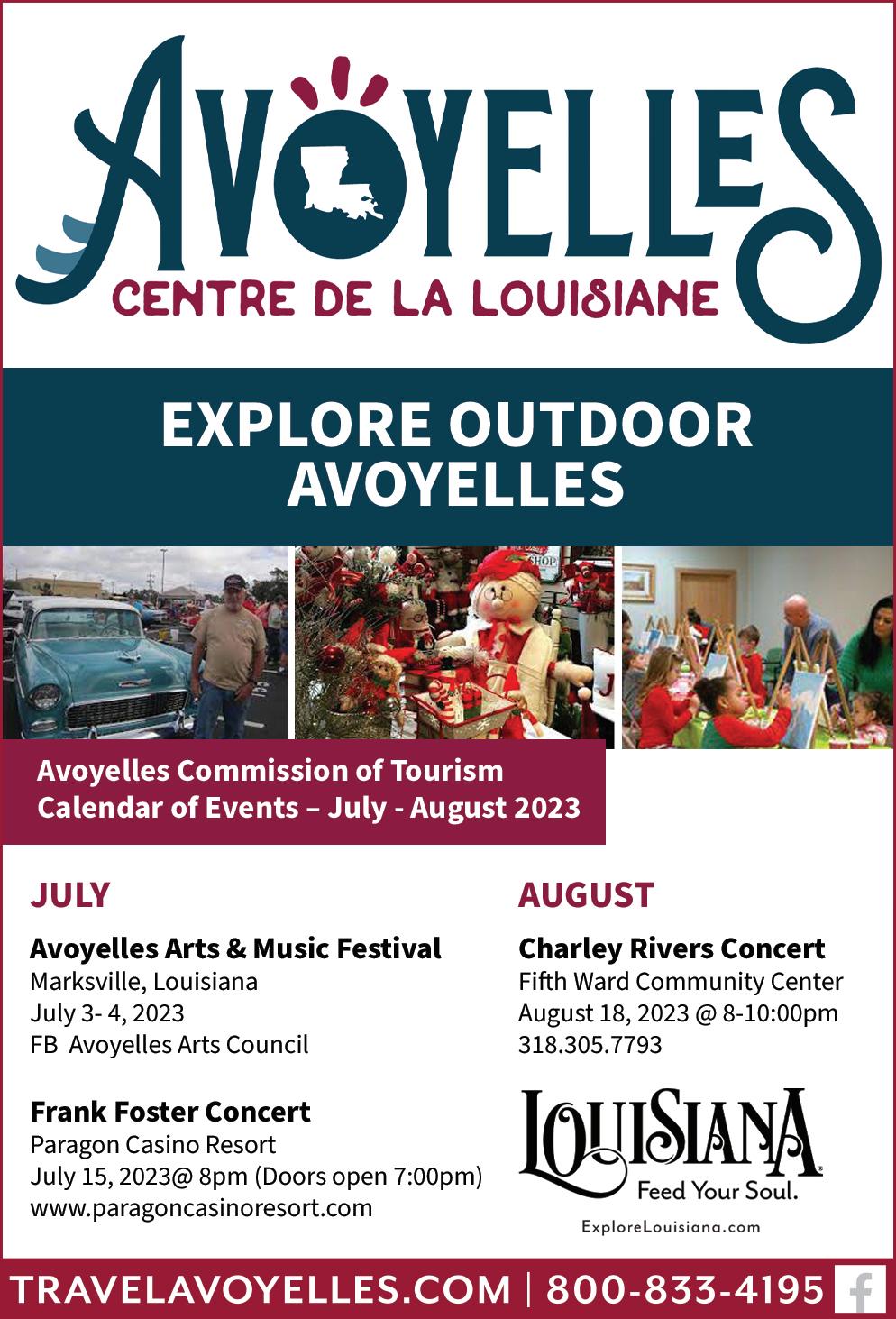
WRITER
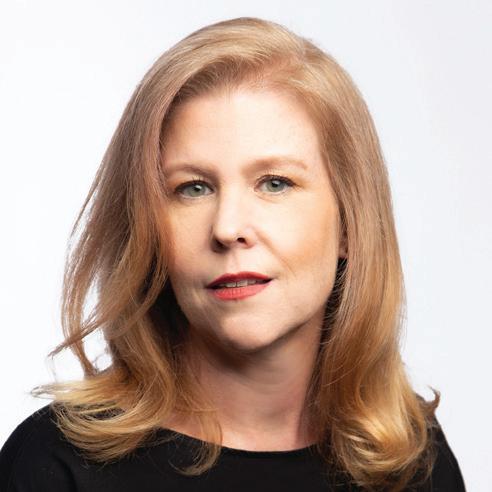
Reine Dugas, Ph.D. is a native New Orleanian and an English professor at Southeastern Louisiana University and an instructor at Tulane University. She’s the Executive Editor of Where Y’at Magazine and publicist for the Tennessee Williams Festival. In addition to co-hosting a literary podcast called “Booktails,” Reine’s creative writing has appeared in publications such as Deep South Magazine, Arkansas Review and South 85 Journal
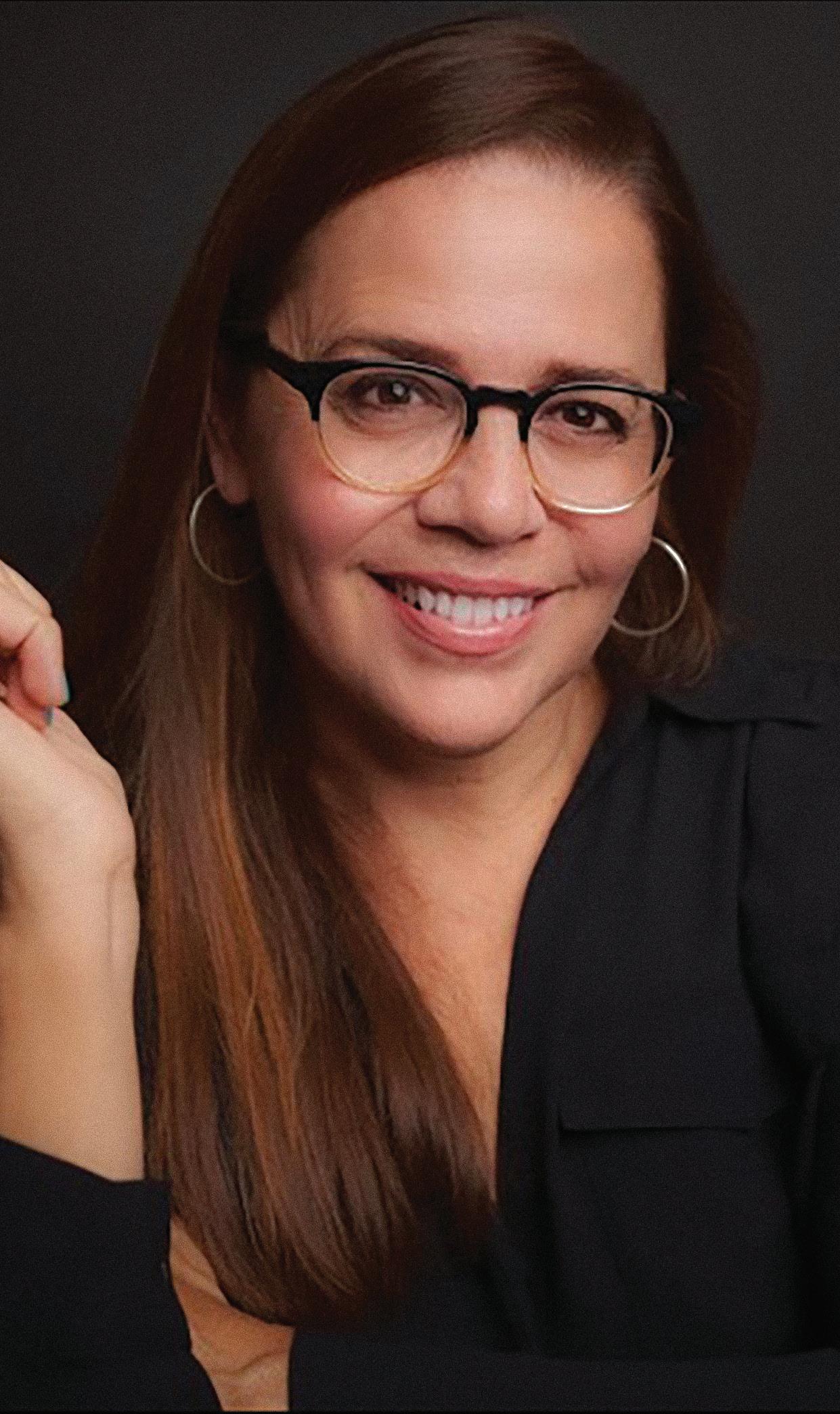
WRITER
Ashley McLellan is the editor of New Orleans Magazine, associate editor of Louisiana Life and a contributor to Biz New Orleans Magazine McLellan has won multiple awards during her more than 20-year career. She has an MFA in Creative Writing from the University of Pontypridd in Wales and also holds a Diplôme de Sabreur from the Confrerie du Sabre d’Or, and will saber a bottle of Champagne in exchange for a glass of bubbly.
WRITER
Jeffrey Roedel is a producer, director and journalist focused on Southern makers, artists and creative thought. A graduate of LSU and the University of Southern California’s Production Workshop, he’s the former editor of 225 in Baton Rouge. In 2020, he released a collection of mantras for creativity called “Life Is Gonna Try to Put a Lot of Polo Shirts on You.” His album of pandemic poetry and music called “Distance” was released in 2021.


FOOD WRITER
Stanley Dry writes the “Kitchen Gourmet” column for Louisiana Life and is author of “The Essential Louisiana Cookbook” and “The Essential Louisiana Seafood Cookbook” and co-author of “Gulf South.” Formerly senior editor of Food & Wine and founding editor of Louisiana Cookin’ magazine, his articles have appeared in Food & Wine, Travel & Leisure, The New York Times, The New York Times Book Review, Boston Magazine and Acadiana Profile, among others.
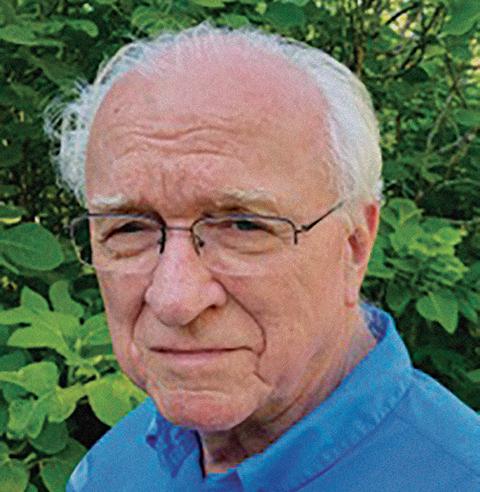
LEAD PHOTOGRAPHER
A native of Lafayette currently residing in the Lake Charles area, Danley Romero specializes in portrait photography. Romero considers it an honor to contribute to his state’s flagship magazine, Louisiana Life, and takes a particular sense of pride in his association with its sister publication Acadiana Profile. Most gratifying are the experiences that collaborating with the two magazines afford: meeting and photographing many of Louisiana’s most talented, accomplished and interesting citizens — the people who help to make our state the wonder it is.


Browse through the Bossier City Farmer’s Market — which opened in April and operating each Saturday through November — enhanced with live music and flanked by several food trucks. Escape the heat at the new indoor customer seating area inside the Pierre Bossier Mall. Each weekend, over 75 venders are displaying their goods. Check out the summer produce and plants, ice-cold smoothies and handmade baked goods, local art, leather and woodworking (bossiercityfarmersmarket.com).
Fresh Off the Docks
Seafood lovers will show their support for Louisiana shrimpers while “passing a good time” with live music and dancing, seafood galore, parades and processions during the Delcambre Shrimp Festival (Aug. 16-20; shrimpfestival. net) and the Louisiana Shrimp and Petroleum Festival (Aug. 31-Sept. 4; shrimpandpetroleum.org).
LAKE CHARLES
Cajun French Celebration
Head to Lake Charles for the Cajun Music & Food Festival (July 15-16) in Burton Coliseum featuring Cajun cuisine and cold beer, arts and crafts, cake walks and auctions, Cajun bands and a Cajun French mass followed by a coffee and donut social. The Miss Cajun Music Pageant is held a week prior to the festival. Proceeds go to McNeese University scholarships (cfmalakecharles.com/ index.php/festival).
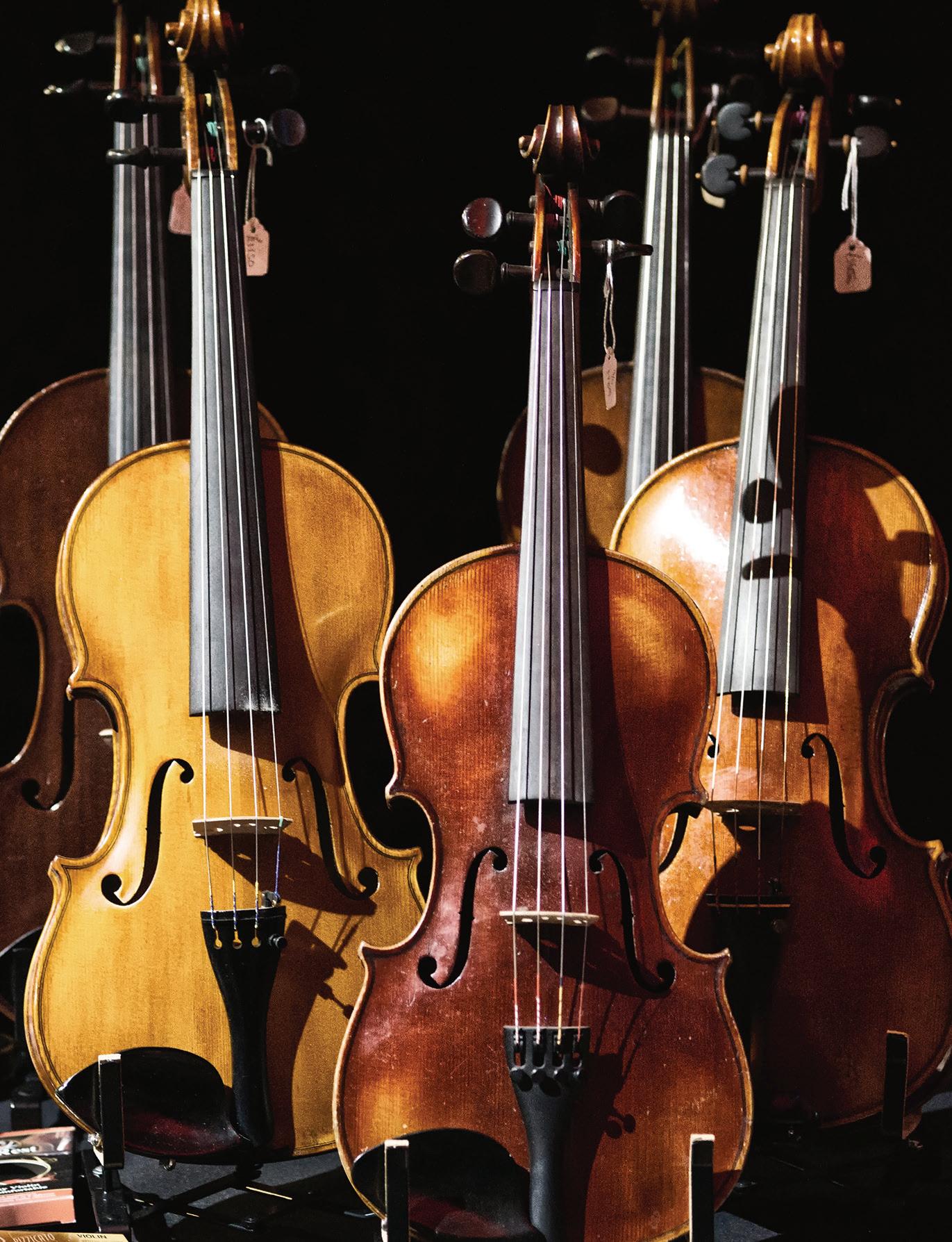
Grab your fiddle and head to the 43rd annual Natchitoches-NSU Folk Festival (July 22) held in air-conditioned Prather Coliseum (NSU campus) featuring the celebrated Louisiana State Fiddle Championship. Enjoy three stages of live music plus Cajun, zydeco and Native American dance lessons, a harmonica workshop, demonstrations on handmade banjos, quilting and blacksmithing plus a gumbo cook-off (nsula.edu).
A man recently caught a two-tone crawfish in the Atchafalaya Basin. The half blue, half red crawfish was pardoned and spared from the boiling pot. For those mumbling the old Cajun saying, “How it knows?” the exoskeleton of a crawfish can turn blue when they produce too much vitamin A. Another oddity recently occurred in North Carolina, where two new species of (very eerie-looking) gold crawfish were discovered. Not to worry, since they exist nowhere else on the planet.
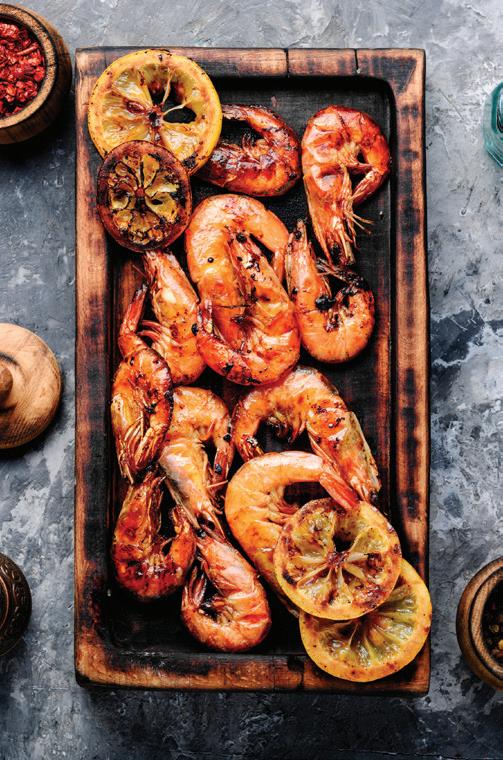
53,000+ LISTENS


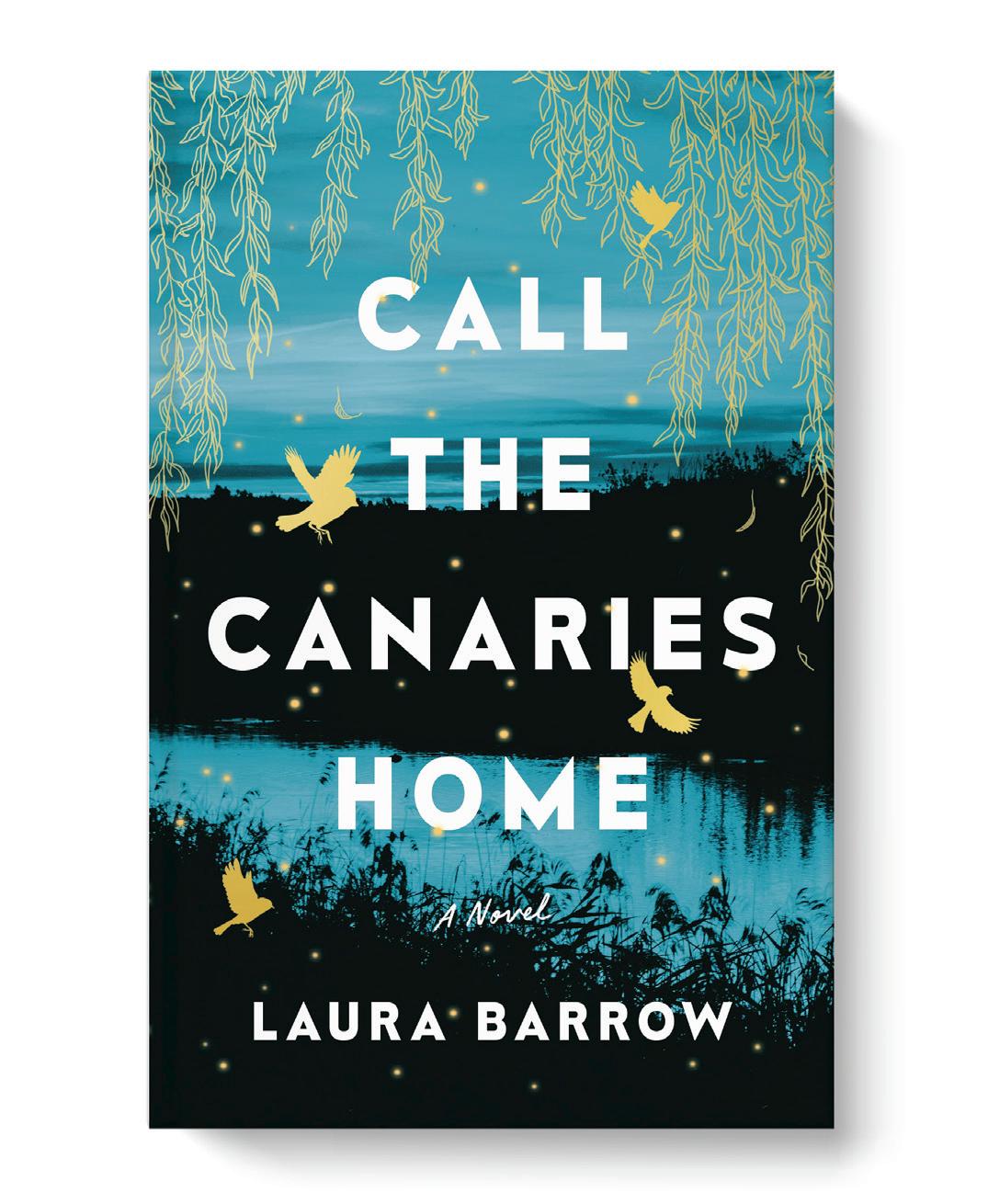
Tragedy strikes 4-year-old Savannah, and her older sisters Rayanne and Sue Ellen, when her twin mysteriously disappears from their family home. Their Louisiana small town is rocked by the event, and the family is soon torn apart. Now, 28-years later, Savannah returns, convincing her estranged older sisters to join her, to fulfill a promise to open the almost three decades-old time capsule the family put together so many years ago. The three quickly uncover an intriguing photo, and a shadowy figure, that could hold the key to solving the mystery of their lost sister. Ghosts linger. Memories return. The sisters must reconnect to confront their past and discover some important lessons about love and family along the way. “Call the Canaries Home” is a remarkable debut novel by author and Louisiana native Laura Barrow. Paperback, 303 pages, $16.99
Mike the Tiger, the iconic mascot of LSU, has been a formidable presence for generations of students and alumni. In “Mike: The Tigers of LSU,” readers get an expert’s behindthe-scenes look at this university icon from Mike’s former veterinarian, David G. Baker. Baker, who cared for the tigers beginning in 1996 with Mike V, recounts his experiences of daily life and routines, questions about the mascot program, game day traditions and even the hard times of sickness and death with Mike VI. “Mike: The Tigers of LSU” also highlights stories and memories of students and other caretakers, and features more than 100 historic photos from Tiger Stadium, Mike’s sanctuary, LSU’s campus and more. Hardcover, 120 pages, $29.95
“The House on Esplanade” by Larry Gray follows the artistic, adventurous, tragic and triumphant story of Bing, a woman who travels the world in an attempt to experience all that life has to offer, both the good and the bad. Raised by her adopted mother, Yvonne St. Amant, after being abandoned by her birth mother practically on the doorstep of the titular house on Esplanade Avenue in New Orleans, Bing learns to embrace life at its fullest. Her adventures will expose her to art, culture, war, sickness, as well as romance, heartbreak and faith. This roller coaster ride is set against backdrops of World War II, 1960s San Francisco, the romantic streets of Paris, exotic Istanbul and more. And yet, through the whirlwind of her life, and its many ups and downs, Bing always returns to that house on Esplanade, the place she would always call “home.” Paperback, 344 pages, $20
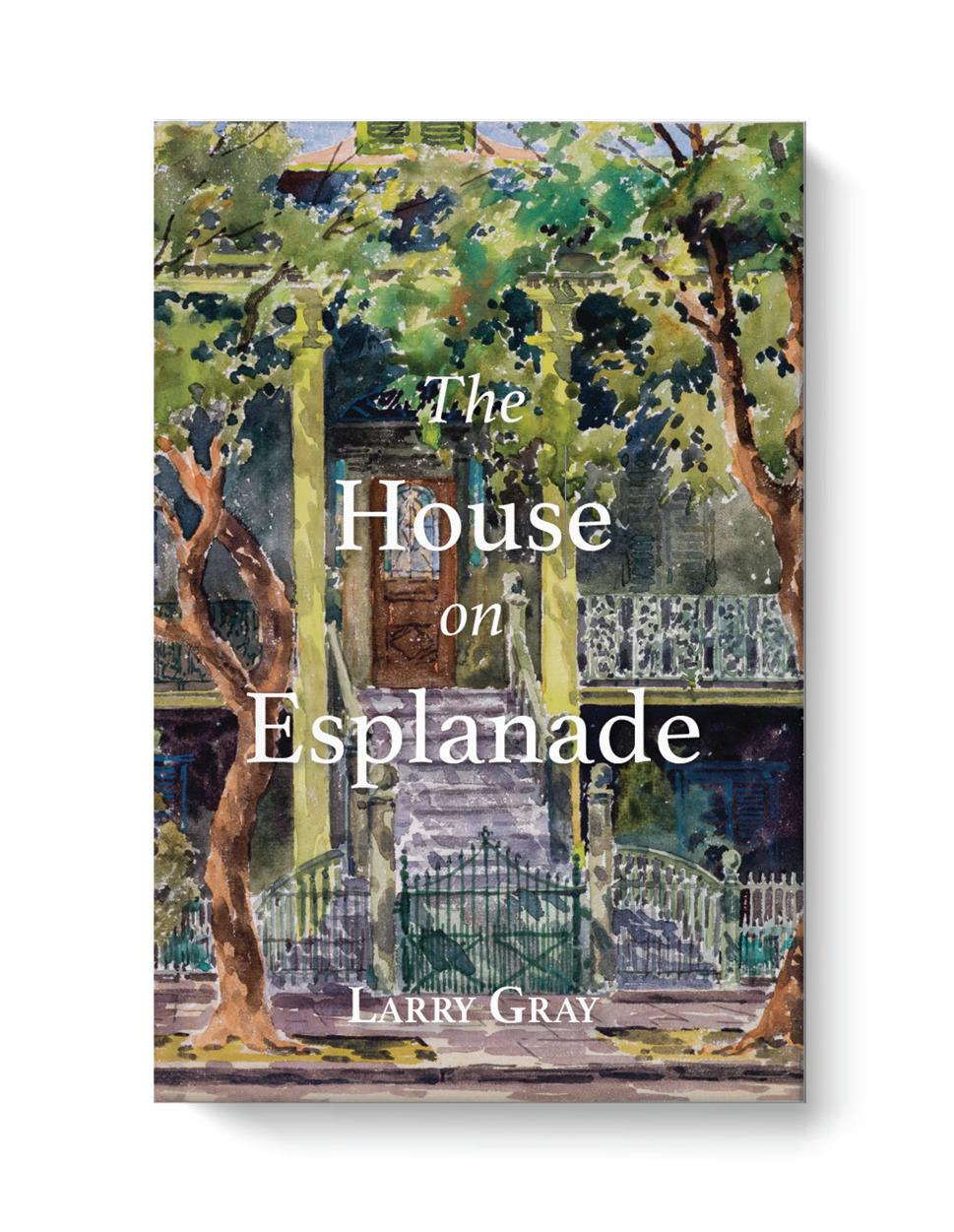
Even the littlest Louisiana Tech football fans can get excited about a cheering on the home team with this sweet retelling of Blue, the university’s fan-favorite bulldog. From Blue’s rescue as a tiny pup to his years as the iconic team hero, “Blue: Louisiana Tech University’s Legend of the Bulldog,” by author, alumna, teacher and librarian Karen Sanders Bean, is a story of friendship, teamwork, bravery and companionship that will resonate with both kids and adults alike. Hardcover, 38 pages, $18.95


Clocking out after eight hours of sanding and painting cabinetry, most evenings Brent Coker can be found wrestling deep in Photoshop with a design that’s been knocking on his brain since before lunch or rolling fast on a skateboard he helped create.
“Sometimes you don’t even know why you’re there, but you go to the park because the energy of the place pulled you,” Coker says. “And you’re skating for about 20 minutes, and it’ll hit you, and friends start pulling up, and you remember that it’s a whole vibe there — a real community.”
The park is in Hammond, a hilly 15,000-square-foot range of concrete lines, twisty-angled ramps and deep, loopy bowls appropriately called Dreamland; designed by the company of the same name that’s been constructing top-rated skate parks all over the U.S. since the 1990s, and more recently in Europe, the Middle East and Mexico.
In the spring of 2005, the Hammond Dreamland Skatepark opened just a couple months before Hurricane Katrina hit, eventually forcing Coker’s family from the West Bank of New Orleans to resettle in Tangipahoa Parish.
Now the park is a hub for a thriving, multigenerational culture founded on recreation, mentorship, style and photography. And almost every day someone there will be wearing a shirt, hat or hoodie declaring with its design that skateboarding can be distilled to a single word: Therapy.
Coker didn’t think of it as therapeutic when he began skateboarding. Inspired by legendary champion skater Tony Hawk’s popular video games, Coker was a 10-yearold just pushing a toy around, he says. But then, life happened. Times got hard, a little more complicated, a little less safe, and one day the reason he loved the sport of skateboarding finally came into full focus.
“It wasn’t until I grew up and went through certain things, hardships in life, that I realized how much I gravitated to my skateboard at those times I felt I couldn’t go talk to others, but the board was there for me to talk to it, and talk through it,” Coker says. “I realized I was expressing certain feelings and thoughts through my skateboarding.”
In 2016, Coker launched Therapy Skateboards, designing colorful and charismatic veneers for decks built by veteran

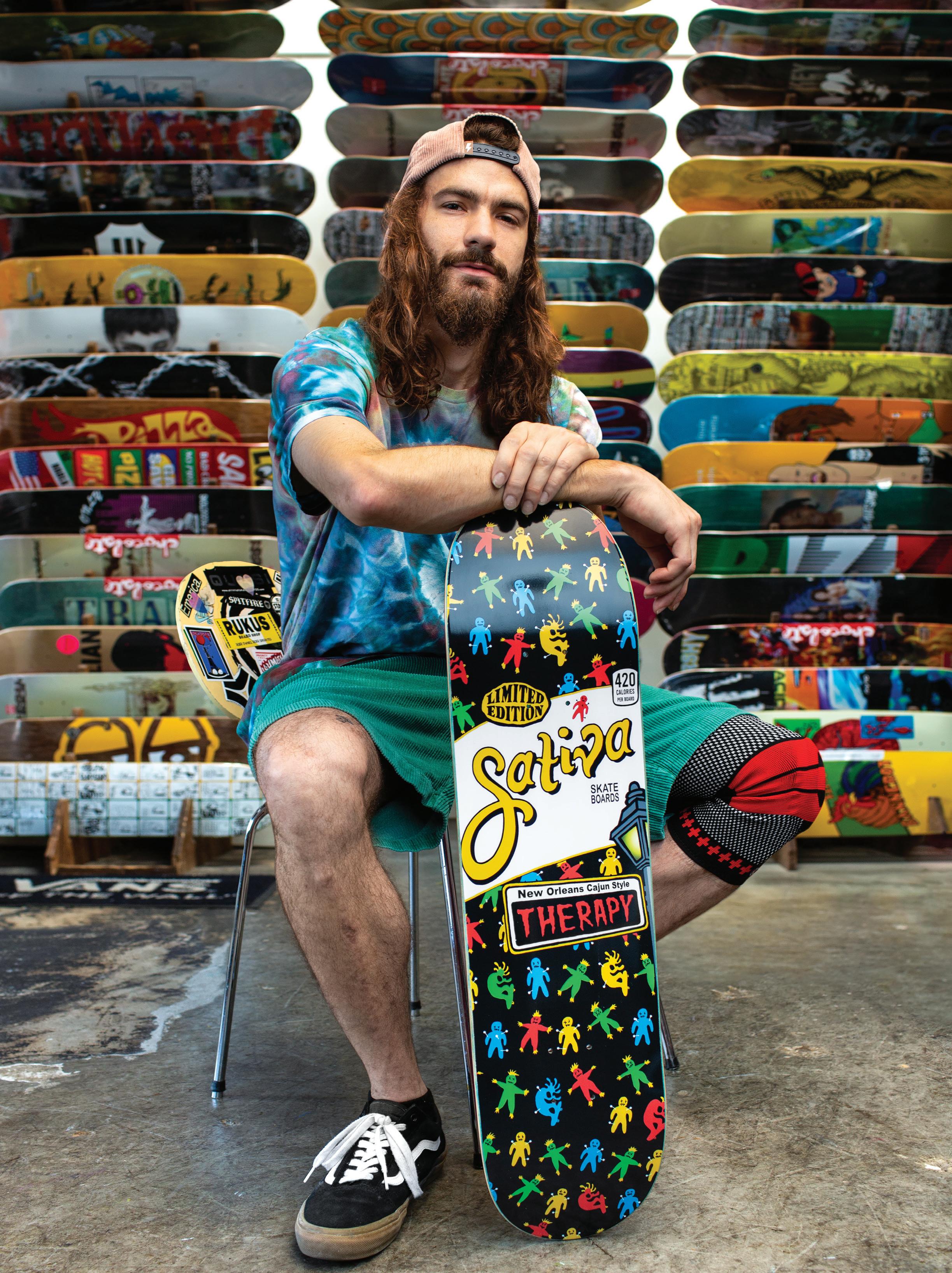
California manufacturers and sold online through his site and at pop-up events across the Northshore.
“I paint cabinets for a living, and a lot of my creativity comes from that time while I’m sanding them,” Coker says. “Creating takes away frustration, it’s like creating new feelings and a path through.”
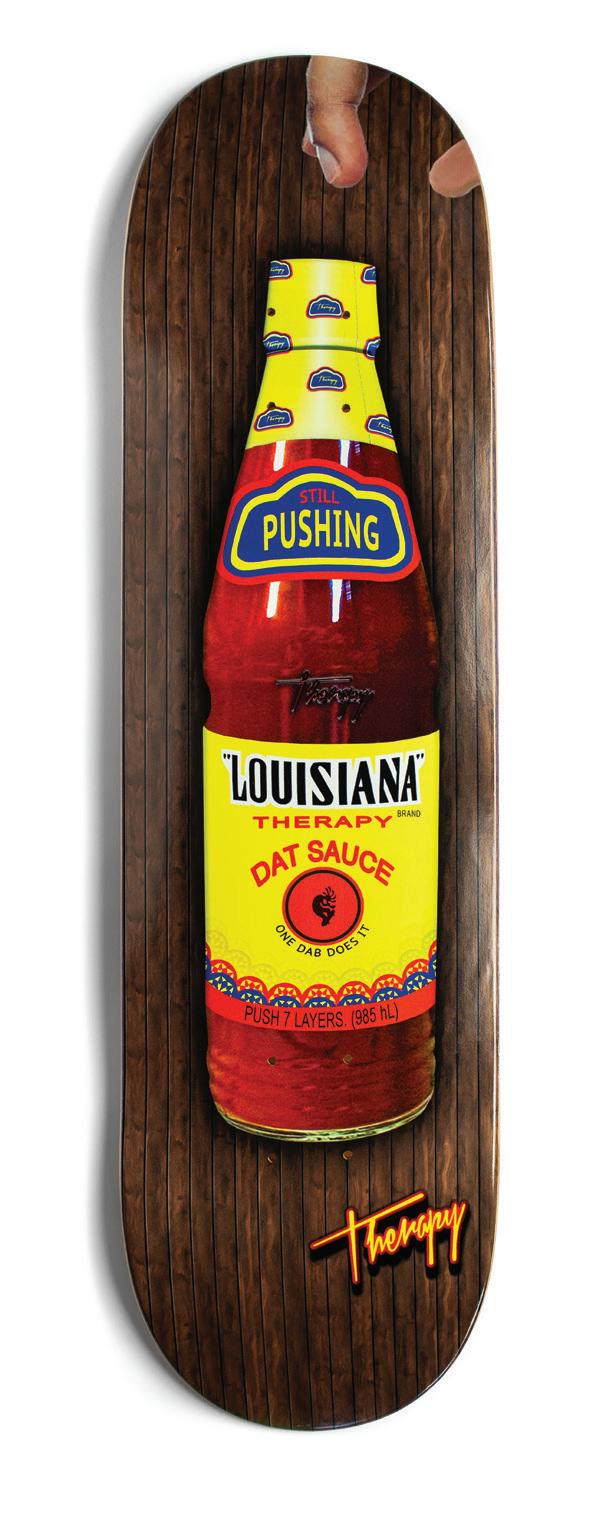
With inspiration from SEGA games to Subway sandwiches, Tetris to transcendental meditation, and Louisiana swamp sunrises to sinuous psychedelia, Coker’s work is largely self-taught, an exploration with plenty of trial and error, he admits, not unlike anyone’s first go at skateboarding.

Since Therapy’s popularity has grown, companies and other artists have reached out. Coker calls each of these resulting collaborations a “blessing-and-a-half.”
The next phase for the brand will be a retail skate shop in Hammond — a new place that, like Dreamland, can be a hub for community and connection.
It’s making that effort as a creative to connect through his art that now motivates him. One of his favorite decks is emblazoned with “Create. Love. Inspire. Repeat.” He almost put that message on a blank white board in bold black text. Very Nike. “Just Do It.” But he decided a design about creativity should be a little more fun, so he introduced splashes of color.
“Watercolor to me says, ‘You don’t know exactly all that’s going on, but something is happening,’ and that’s creativity to me,” says the craftsman and entrepreneur who never considered himself an artist, but writes poetry and plays guitar in his spare time. “When we create things we love and put them out in the world, we inspire someone else, and the process repeats itself.”
your first your 10th Can you what skating you? I fell in love with it. It grabbed me, and I grabbed it. And never put it down. And that’s the biggest thing I’m grateful for, I’m still falling in love with it. I’ll be at the park now and it’ll hit me suddenly, ‘This is so much fun.’
your favorite Therapy right now?
The collab pants we did with Televisi Star (TVS), a clothing company based out of Bali, Indonesia. Big shoutout to Indra Leonardo, the owner! Every time I put them on, I immediately feel good and comfy, ready to go throw a heelflip over something or just chill.
you enjoy not deTherapy or skateboarding? I try to spend time with family and friends who don’t skate. On a weekend night I may go to Benny’s Place in downtown Hammond. But I love time with the homies doing anything. I love my tribe. I also write a lot of poetry. Part of my most recent one goes like this: “Televisi Star. It must be the pants. Or the people. Who sew the seams. Either way I salute to the ones who smack alarms. But then get up. Consistently chasing dreams. Don’t complain about it. Just working hard. Overtime. No recording. Behind the scenes. Just a heavy grind. And a lot of pushing. For what they believe.”

The 19th-century American artist James McNeill Whistler once wrote, “Nature sings her exquisite song to the artist alone.” Today, however, a growing number of passionate young Louisiana artists are hearing not nature’s “exquisite” song but one of ecological distress in a rapidly changing world.
One answering that call is New Orleans artist Hannah Chalew who is working with various Black-led community activist organizations in Louisiana’s River Parishes, so-called Cancer Alley, to call public attention to what she describes as social injustice and environmental issues brought on by the fossil fuel and plastic industries. Chalew equates the refineries along the river to the old sugarcane plantations in that both, she says, victimized local African-American residents, many of whom are descendants of those same enslaved people. Today, it’s fossil fuels and plastics, she says, back then, it was sugarcane.
This venture into environmental advocacy art has been quite a journey for Chalew. Born in Baltimore in 1986, she grew up in New Orleans where she attended Benjamin Franklin High School and the New Orleans Center for Creative Arts. She majored in art and
minored in anthropology at Brandeis University before going on for a master’s in fine arts at the Cranbrook Academy of Art in Michigan. Returning to New Orleans in 2018, she signed up for the Fossil Free Festival’s “toxic tour” of the River Parishes. It changed her life and gave new direction to her art.
That journey hasn’t gone unrecognized. She has received numerous grants and her work has appeared in shows across the nation. Last summer she received the Southern Prize awarded by the Atlanta-based South Arts organization. Her work placed first among artists from nine southern states. The natural and unusual materials she used in her art impressed jurors.
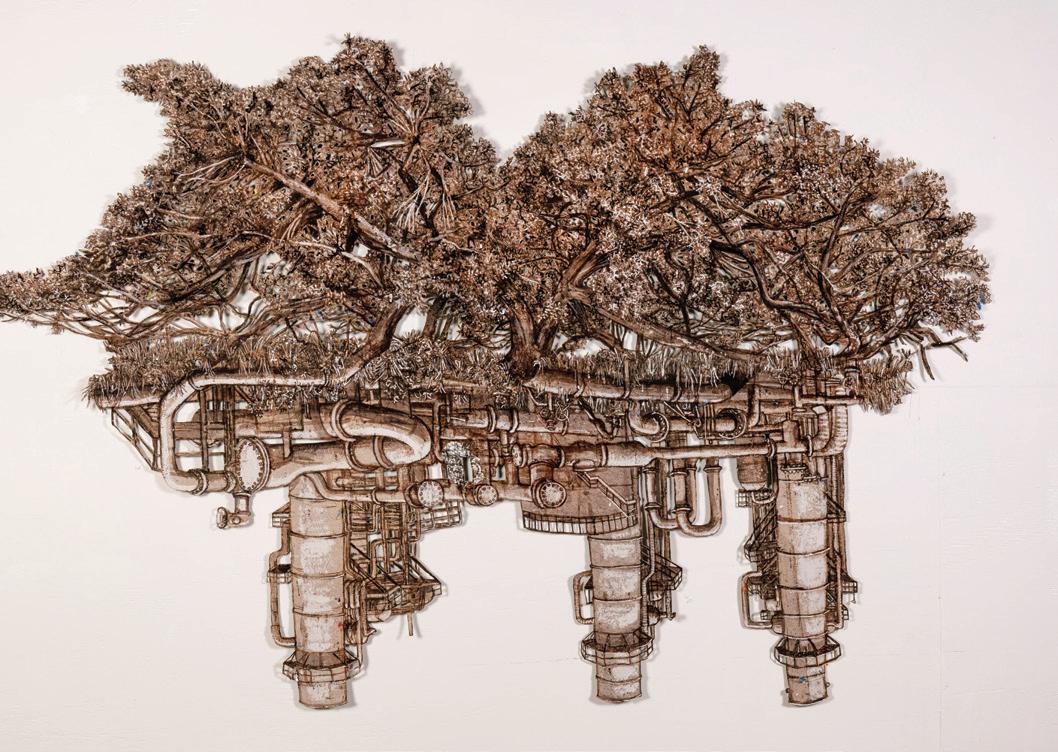
Those materials are indeed unusual. Not shy about wallowing in the muck, she makes her installations, drawings, prints and conceptual sculpture with pollut-
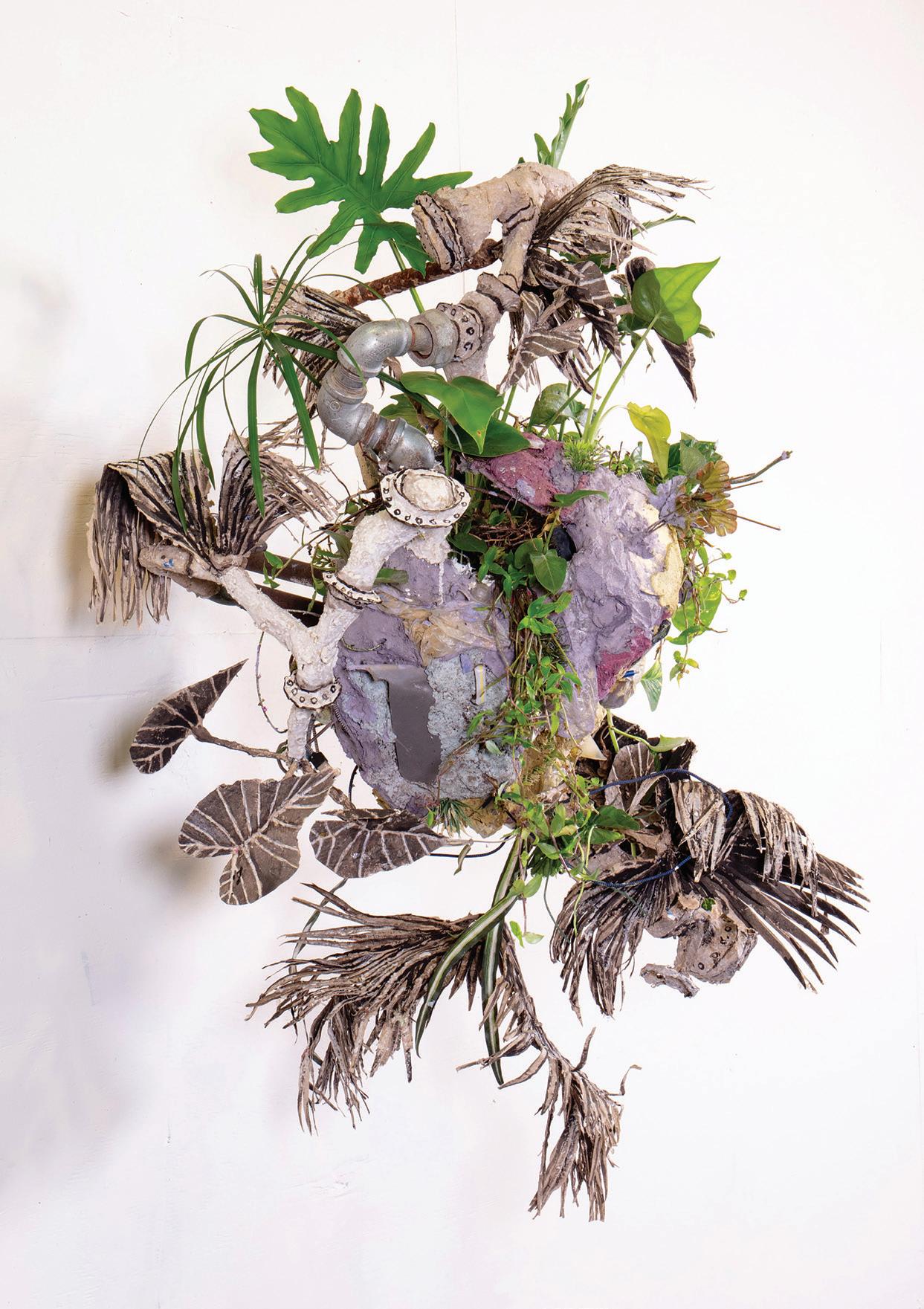

ants she finds in the streets and near industrial sites. She does so because she wants viewers to respond “viscerally” to a world and region in serious ecological trouble. In some works she tries to visualize South Louisiana without people. Her prints portray grass- and vine-covered man-made waste products and abandoned underground pipelines that already exist in South Louisiana. To Chalew, the plants give viewers hope.
“I’m trying to understand how we got to this place,” says Chalew, sitting out among her vine-laced “Orbs” hanging in the patio of her studio located in an old millwork factory in the city’s Bayou St. John neighborhood. “I want to make work that imagines the future and, hopefully, helps inspire people to want to change
and reconsider the way we are living. We can’t avoid using plastic products in our everyday life, but there are individual decisions we can make to live more sustainably and in harmony with the environment. To me this work is like imagining what the future might look like if we don’t change course. The remnants of all of this will still be here on the planet but maybe we’re not.”
Every aspect of her art includes subplots about pollution, waste and renewable resources. For instance, she makes paper from bagasse, the pulp residue from ground sugarcane that she gets from South Louisiana sugar refineries. She infuses in the paper bits of shredded plastic. She describes both as sustainable resources and “specific to this landscape.” To construct her “Orbs” — varying sized hanging pods with vines growing from within — she uses the same bagasse-based sugarcane paper mixed with lime and recycled paint with embedded found objects.

“The paper itself is a document, telling a part of the story,” says Chalew. “In my drawings you can see the image from far away, but as you get closer the image becomes less discernible and you might see a piece of foam or recognize a product. Again, I want you to think about how you are implicated in it. I’m also thinking about beauty and this darker side and how to utilize that to move people.”
Like the sugarcane paper, Chalew also makes inks for her drawings and prints. One is made from grinding chunks of coal she finds in the ditches near a River Parish coal transfer plant. She mixes the coal dust with gum arabic and water. Another ink she makes from oak gall pods made by wasps when they lay eggs in oak trees. She soaks the nodules, grinds them and adds iron.
Chalew supports her art through sales but mostly by grants that she shares with activist groups. Staying true to her beliefs, she says she is divesting herself as much as possible from fossil fuels. That includes refusing to accept money or participate in art shows underwritten by fossil fuel corporations. She also rides her bike to and from her studio and powers her studio and artworks with solar energy and rainwater.
“It’s hard in Louisiana because it is our industry,” she says, “but we can think bigger and imagine a different future.”
For Chalew, art is not simply the old axiom “Art for art’s sake.” Art is a tool for change, a tool for survival, a tool for social and environmental justice and responsibility.
“I think when we have deeper relationships to our environment,” she says, “it’s harder to exploit a place if you are more connected to it.”
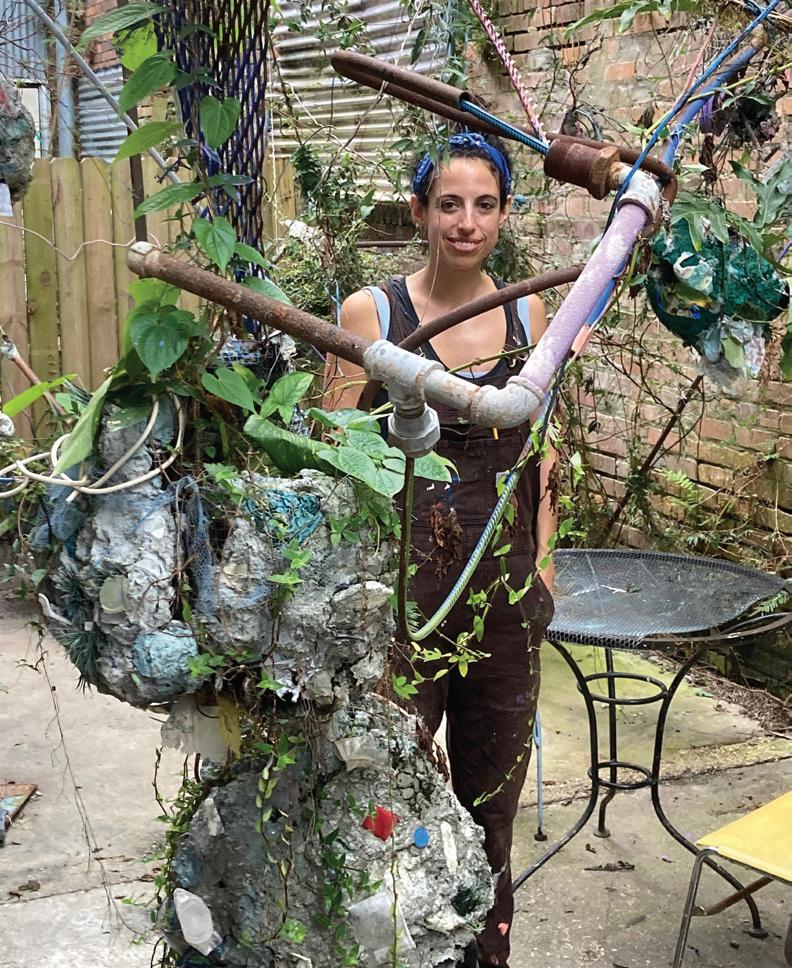
For more information, visit hannahchalew.com n
CAJUN
Back Roads to Back Yards: The Flora and Fauna of South Louisiana
Wildlife photography by LeeAnn Hepler, through October.
Wedell-Williams
Aviation and Cypress Sawmill Museum, Patterson. louisianastatemuseum.org
CENTRAL
Connected
Visions: Louisiana’s Artistic Lineage
Overview of Louisiana’s artistic heritage, permanent exhibit. Alexandria Museum of Art. themuseum.org
PLANTATION
Our Louisiana Louisiana art from the permanent collection, through Jan. 14, 2024. Louisiana Art & Science Museum, Baton Rouge. lasm.org
NOLA Knowing Who
We Art: Rise of Abstraction, Vernacular Art Photography
Rise of contemporary art in the South, through March 3, 2024. Ogden Museum of Southern Art. ogdenmuseum.org
NORTH
Sisters in Art: Women Artists from the Norton’s Permanent Collection
Historical and contemporary women artists in museum’s collection, ongoing. R. W. Norton Art Gallery, Shreveport, rwnaf.org

 BY LEE CUTRONE PHOTOS BY SARA ESSEX BRADLEY
BY LEE CUTRONE PHOTOS BY SARA ESSEX BRADLEY
Artist and collector Andrew Lamar Hopkins lived in Tremé when he decided to rent a light-filled French Quarter apartment as a studio for painting. It didn’t hurt that the historic 19th-century building has a huge wraparound balcony overlooking the French Market, and that it dates to Hopkins’ favorite era of fine and decorative arts.
“The thing that drew me to the space is the light,” says Hopkins, who planned to continue living in Tremé, but quickly had a change of heart as he filled his second address with the beautiful antiques and art he’s collected since his teen years. “My collection took over. And I like being able to get out of bed and paint.”
Both Hopkins’ French Quarter and Tremé abodes are brimming with Old Paris porcelain, historic portraits, antique furnishings and other finds — mostly dating from the late 18th century to the mid 19th-century — as well as his own paintings, and both are featured in the new book, “The New Antiquarians: At Home with Young Collectors,” by Michael Diaz-Griffith, published in June. In the last few years, Hopkins’ faux-naif, period-accurate paintings of 19th-century Creole interiors exploded onto the international art scene with exhibitions in New York and Paris and articles in a host of publications including The New York Times and The Wall Street Journal.
Hopkins often uses the second-floor apartment’s wraparound veranda for entertaining. (Facing Page) Hopkins, who had his own antique shop during the 1990s, primarily collects antiques from the late 18th century to the mid 19th-century.
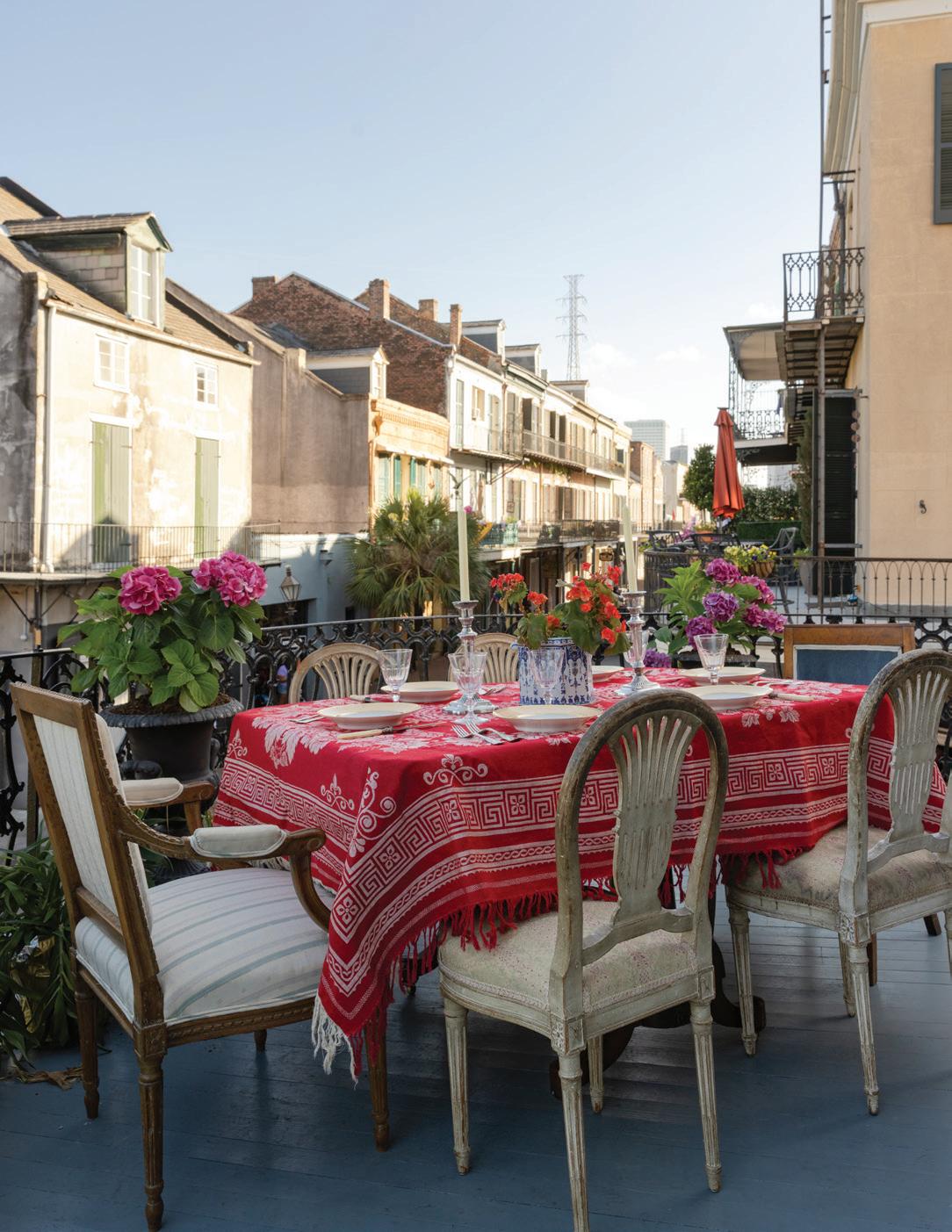
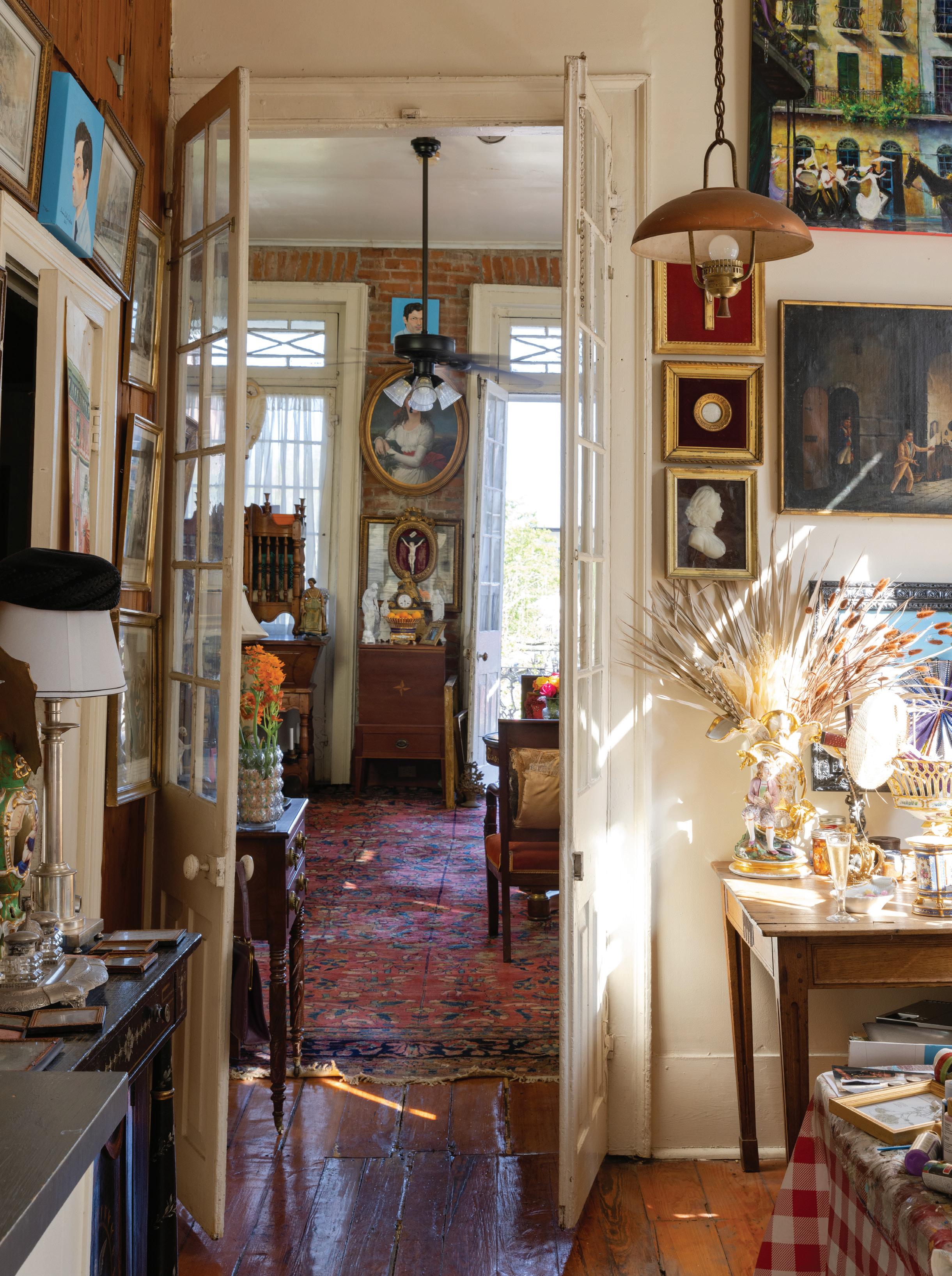
Above the salon’s French Empire settee, in the center, is an 1848 portrait (purchased at auction in upstate New York) depicting siblings and their respective arts, and groupings of miniature portraits.

Hopkins is the first living African American artist to have a solo exhibition in the Cabildo. He has a following of thousands on Instagram and his works sell for tens of thousands of dollars. Yet for Hopkins, collecting period pieces is as much of an art as putting brush to canvas. Whether purchased at a Paris flea market or discovered locally, every item has a story, and Hopkins, who considers himself the custodian of his treasures until they are passed on, loves sharing their details.
Hopkins’ journey as an antiquarian began while growing up in Mobile, Alabama where his grandmother and mother were occasionally gifted with “hand-medown antiques” by the families they worked for and where Hopkins himself befriended owners of antique stores to learn about their wares.
“I always gravitated toward something old and toward architecture,” he says.
The money he earned working in antique shops went toward small purchases such as vases, often with a chip or a tiny flaw that lowered the price. Over time, those modest acquisitions gave way to larger, more important ones and to the wealth of knowledge Hopkins has today.
His fascination with ancestry is evident in the profusion of portraits that surround him. Among the many portraits hung gallery-style in the apartment, are rare wax miniatures (known for the lifelike quality that the wax gives to the subject’s skin), an important painting of a white Creole boy by 19th-century French painter Jean Joseph Vaudechamp, who regularly visited New Orleans in the 1830s, and a large portrait of a free woman of color found
INTERIOR DESIGN
Andrew Lamar Hopkins
SQUARE FOOTAGE
Approximately 600
OUTSTANDING FEATURES
Original hardwood cypress floors, French doors and transoms, spacious wraparound veranda with original ironwork, international mix of art and antiques.
in France. A portrait of a bonneted French woman circa 1840, whom Hopkins calls French Aunt Pitty Pat, hangs above the casement opening leading into the salon. A cache of daguerreotypes housed inside tarnished velvetlined cases is displayed near the kitchen.
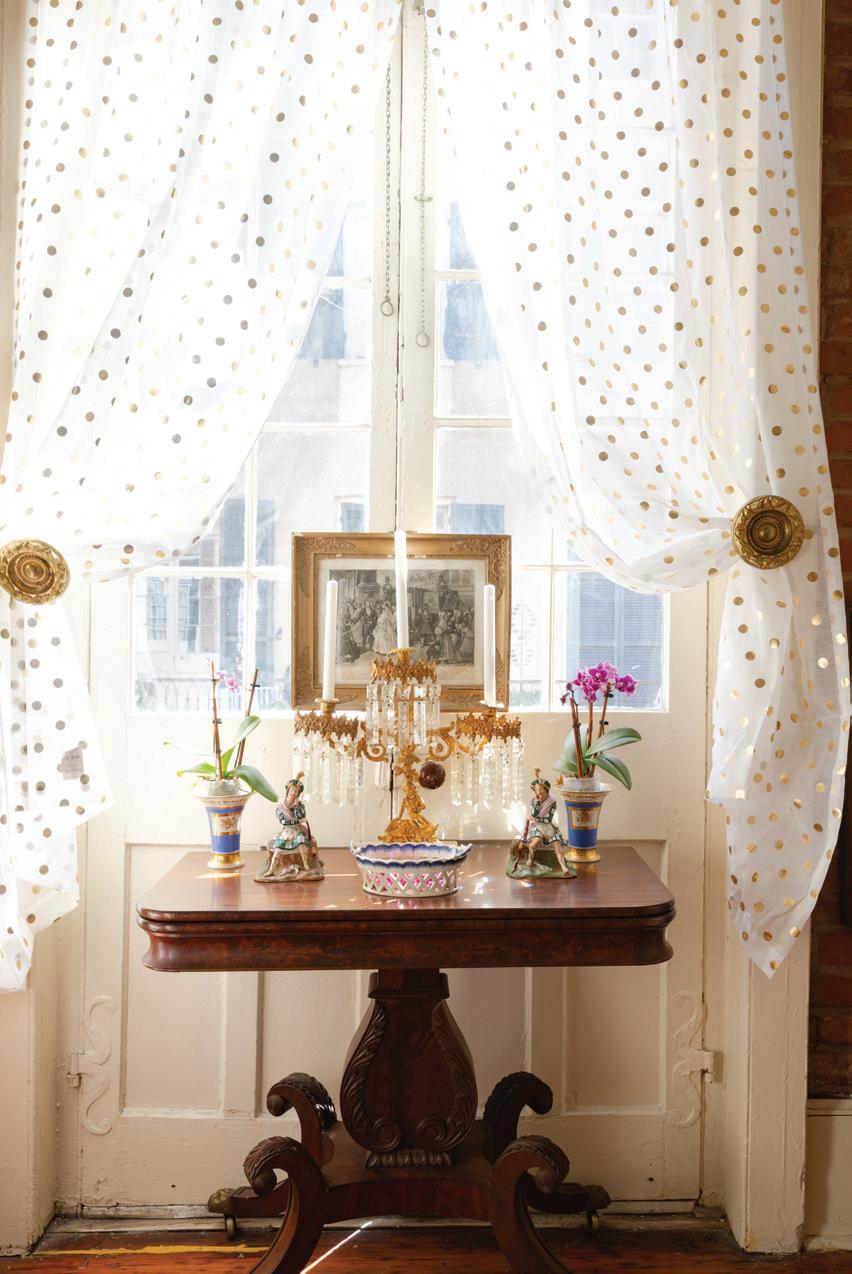
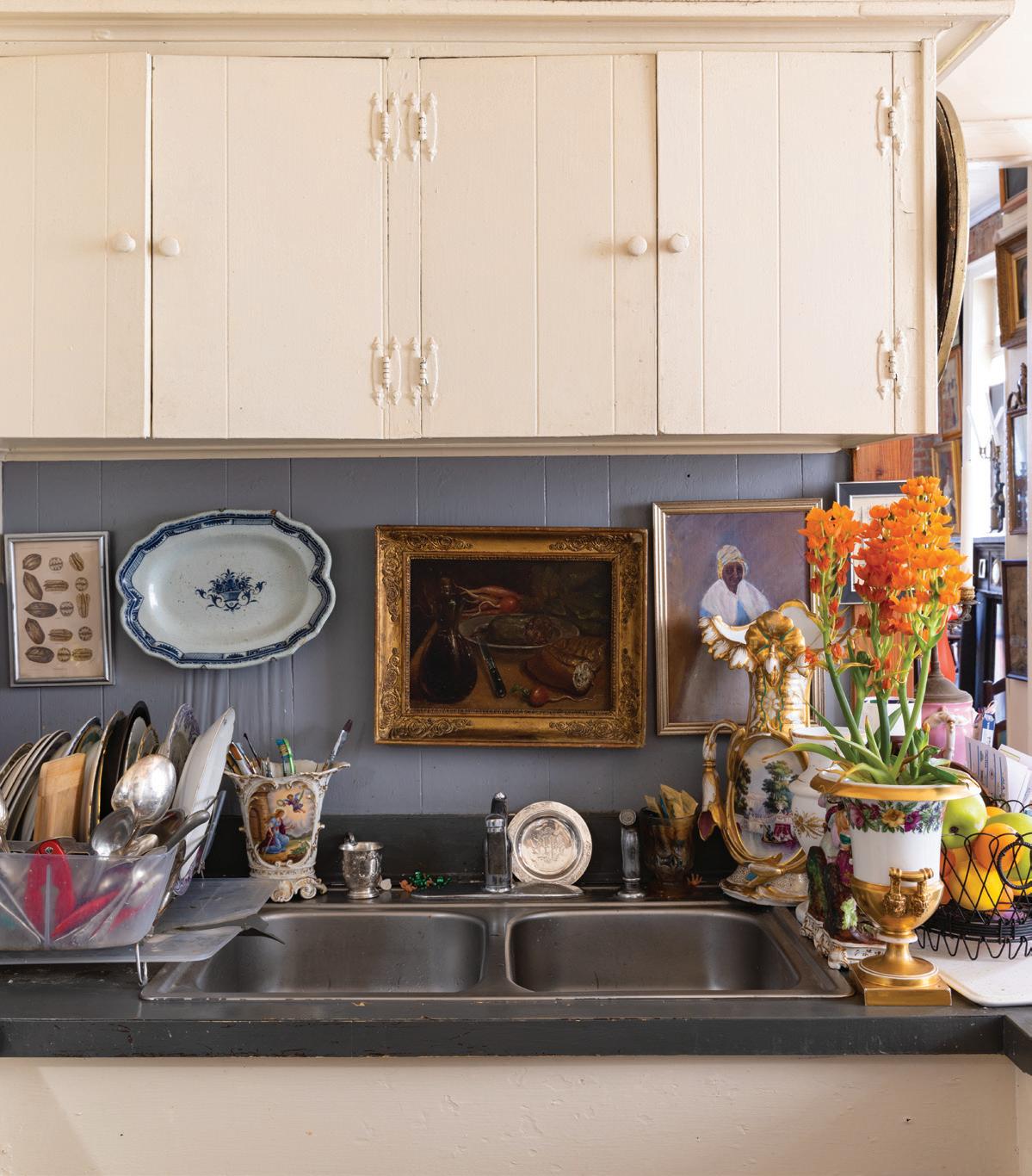
“Instant ancestry,” he says, using the term that a friend gave the many faces on his walls and tabletops, as he examines a daguerreotype.
Hopkins has no need of inventing ancestry. His own Creole ancestry dates back to a Frenchman named Nicolas Baudin, who obtained a Louisiana land grant in 1710. The kinship that he feels toward the relics in his apartment is more about his powerful connection to the past than the DNA of those depicted in the portraits. The identities of some are known, others are not.

The more-is-more 19th-century salon atmosphere of Hopkins’ French Quarter home also owes to the plentiful collection of Old Paris porcelains (a testament to Hopkins’ love of France, which he visits every chance he gets), to the variety of antiques, and to the lovely vignettes he creates. The oldest piece, an English skeleton clock, dates from 1680. There is a tapestry chair from 1715, an 18th-century buffet used as a bar, a cage-like panetiere, a dough boy and a wooden chest for chilling champagne picked up at an estate sale just a week earlier. Here and there, a cheeky present-day curio such as a risqué corkscrew, is thrown in for fun.
Refreshingly, Hopkins, a true connoisseur of antiques, enjoys his possessions on a daily basis. He entertains weekly and generously shares the contents of his world with his guests. Over lemonade in crystal stemware and ladyfinger shaped cheese straws from his home state of Alabama, he surveys the well-suited pairing of 1830s architecture and antique artifacts.
“I love Creole architecture and I think my things look beautiful here,” he says. n
The scientific name for the blue crab (Callinectes sapidus) means “tasty (or savory) beautiful swimmer,” and that is a most fitting description considering how delectable crab is and how many ways it can be prepared and served. The sweet and tender meat is delicious with either mild or spicy seasonings in preparations as diverse as boiled crabs, crab salad, crab cakes, bisques, gumbos and étouffées and as a stuffing for vegetables or fish. Not to mention soft-shell crabs, one of our greatest delicacies, which can be deep fried, pan fried, broiled or grilled. We are fortunate to have an abundance of blue crabs in Louisiana. The blue crab industry is one of the largest fisheries in the state, but it is estimated that at least 75

2 small mirlitons (about 8 ounces each)
4 ounces lump crabmeat
1 tablespoon chopped chives
1 tablespoon freshly squeezed lemon juice coarse salt and freshly ground black pepper to taste
1 tablespoon breadcrumbs
1 teaspoon chopped parsley
1 teaspoon freshly grated Parmesan
1 teaspoon extra virgin olive oil
COOK mirlitons in boiling salted water until they’re easily pierced with a skewer, about 45 minutes. Drain and refresh under cold running water. Grease a baking dish and preheat oven to 350 F.
WHEN COOL ENOUGH TO HANDLE, cut mirlitons in half lengthwise. Scoop out flesh, leaving a quarterinch shell. Season shell with salt. Chop mirliton flesh and combine with crabmeat and chives in a bowl. Season with lemon juice, salt and pepper. Fill mirliton shells with crabmeat mixture. Combine breadcrumbs, parsley, Parmesan and olive oil. Spoon over mirlitons. Bake until heated through, about 20-25 minutes minutes. Makes 4 servings.
Blue crab is a summer staple in Louisiana and is as versatile as it is delicious
percent of the catch is exported, which accounts for the big price increases we have experienced in recent years. The main market for Louisiana crabs is the Chesapeake Bay area, where the crab population has been declining for decades. The Bay’s estimated crab population was about 227 million crabs in 2022, a 19 percent decrease from the previous year and a fraction of the 852 million crabs in the 1993 survey.
One of my favorite crab dishes is crab cakes, a preparation that varies greatly from one cook or restaurant to another. Unfortunately, some crab cakes contain too many breadcrumbs. There should be just enough binding to hold a crab cake together — and no more — so that the slight pressure of a diner’s fork will cause it to crumble. Lump or jumbo lump crabmeat is usually preferred for crab cakes, but price pressures may dictate using some claw crabmeat in the mix, which can actually improve the flavor of the dish. For a change from the usual mayonnaise-based sauces, try a piquant béarnaise sauce.
Two of the following recipes are simplicity itself. A quick and refreshing dish combines crabmeat with capers and lemon. Instructions call for only a quick warming of the crabmeat, but an alternative is to make a cold salad, with olive oil instead of butter, which requires no cooking at all. The recipe for crabmeat and asparagus with a mustard vinaigrette can be served at room temperature or chilled, depending on your preference.
The recipe for mirlitons with crabmeat requires a little more work, but the result is worth it. The crabmeat stuffing can be used with other vegetables, such as tomatoes or peppers or a combination of the two. n
2 tablespoons unsalted butter
1 pound lump crabmeat
1½ teaspoons capers, drained and rinsed
½ teaspoon lemon juice coarse salt, freshly ground black pepper and cayenne to taste
1 tablespoon chopped parsley
IN A NON-REACTIVE SKILLET over medium heat, melt butter, add crabmeat and heat through. Add capers and lemon juice, season with salt and pepper, and sprinkle with chopped parsley. Makes 4 servings.
1 pound lump crabmeat (or lump and claw)
1 teaspoon Cajun/Creole seasoning
2 tablespoons lemon juice
1 tablespoon chopped parsley
1 tablespoon chopped green onion tops
1 egg, lightly beaten
½ cup breadcrumbs
For Frying
¼ cup clarified butter
¼ cup flour
1 egg, lightly beaten
½ cup breadcrumbs
For Serving
Béarnaise sauce (recipe follows)
PLACE crabmeat in a mixing bowl. Add Cajun/Creole seasoning, lemon juice, parsley, green onion tops, egg and breadcrumbs. Mix gently with a fork. Be careful not to break up crabmeat. Form mixture into 4 cakes.
IN A LARGE SKILLET, heat clarified butter on medium heat. Dredge crab cakes in flour, then egg, then breadcrumbs. Fry until browned, about 4 minutes; turn and cook on the other side until browned, about 2 minutes. Drain on absorbent paper. Serve with béarnaise. Makes 4 servings.
BÉARNAISE SAUCE
¼ cup white wine vinegar

¼ cup extra-virgin olive oil
2 tablespoons freshly-squeezed lemon juice
1 tablespoon Dijon mustard
Coarse salt, freshly ground black pepper and cayenne to taste
1 pound thin asparagus
1 pound lump crabmeat
COMBINE olive oil, lemon juice and mustard in a bowl and whisk until emulsified. Season with salt, pepper and cayenne.
TRIM ends from asparagus and cook in boiling salted water until tender. Remove asparagus with tongs and drain in a colander. Place asparagus on a clean kitchen towel and blot dry.
DIVIDE asparagus among 4 serving plates and top with crabmeat. Drizzle with vinaigrette. Makes 4 servings.
1 tablespoon minced shallot
2 teaspoons chopped fresh tarragon
2 black peppercorns, bruised with side of a large knife
pinch salt
dash cayenne
3 egg yolks
1 cup clarified butter
1 teaspoon chopped parsley
COMBINE wine vinegar, shallot, half of tarragon, peppercorns, salt and cayenne in a small pan and boil until reduced to a few tablespoons. Transfer to a stainless steel bowl and cool. Add egg yolks and whisk to combine. Place bowl over a pot of simmering water and cook, while whisking, until mixture thickens. Begin slowly adding butter while whisking. Continue adding butter while whisking and moving bowl away heat and back in heat until butter is incorporated. Strain sauce through a fine mesh strainer into a serving bowl. Add remaining herbs and stir to combine. Makes about 1 cup.
EVERY LOUISIANIAN SHOULD KNOW AND PLACES
EVERY LOUISIANIAN SHOULD GO
By Cheré Coen
We would amend Williams’ comment to include all of Louisiana. With apologies to Cleveland — seriously, we mean no harm — our state differs from others in so many ways, many of which are the reason tourists flock to our bayous and cities. We have parishes instead of counties, Napoleonic Code instead of common law and our cuisine differs from Southern styles, making it one of the most unique American foodways. ¶ Naturally, newcomers scratch their heads at our uniqueness, so we’ve compiled a field guide to help you out.
For those who prefer a rational explanation, these are swamp gases emitted from rotting vegetation, also called will-o’-thewisp in English. They appear as floating lights so perhaps they are evil spirits messing with those courageous enough to venture near. Some believe they are the souls of unbaptized babies and if you follow the lights, they will lead you astray.
The Audubon Nature Institute and City Park Conservancy are twin jewels in the Crescent City’s crown. The former works to conserve and protect endangered species and habitats as well as educate the public through its Zoo (within beautiful Audubon Park), Aquarium and Insectarium. The latter has been providing space for recreation, cultural institutions and nature — one of the largest urban parks in the United States — for more than 170 years and was recently transitioned to a nonprofit conservancy.
Both parks and associated attractions offer days of enlightenment and fun, but new this summer is the reopening of the Audubon Aquarium, including the Insectarium relocation to the former IMAX Theatre at the New Orleans Riverfront. City Park added four pickleball courts to its Tennis Center, which joins the Botanical Garden, Louisiana Children’s Museum and Storyland. audubonnatureinstitute.org; neworleanscitypark.org.
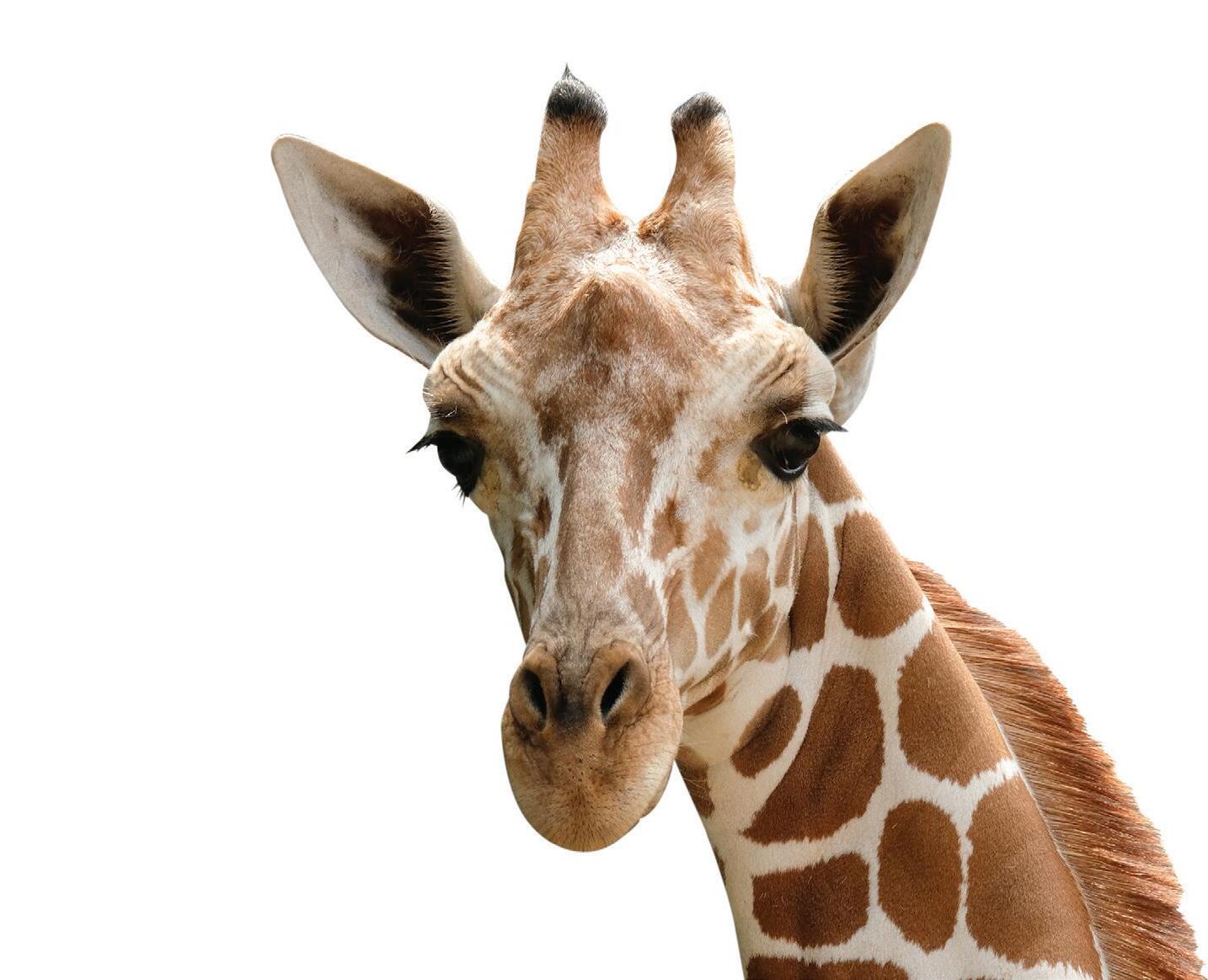
“America has only three cities: New York, San Francisco and New Orleans. Everywhere else is Cleveland.”
—TENNESSEE WILLIAMS

When the LSU Tiger football team plays at home, Tiger Stadium fills to the brim with around 100,000 screaming fans, making the stadium the fifth largest city in Louisiana for those few thrilling hours. Then there are the thousands of tailgaters on the stadium’s periphery. Saturday night in Death Valley is more than football, however. Don’t miss the Golden Band from Tigerland march down Victory Hill into the stadium, then perform their dramatic pre-game show with a goosebump-inducing version of “Tiger Rag.”

SHOULD KNOW
Isaac Toups, owner of the acclaimed Toups’ Meatery in New Orleans, admits that it takes a few oysters — or “ersters” as some locals say — to get the hang of shucking.
“You get good after about 1,000 of these,” he advises in his cookbook, “Chasing the Gator: Isaac Toups and the New Cajun Cooking.”
Toups suggests having three items on hand to shuck an oyster: an oyster knife for your dominant hand, a cut-resistant glove for the other and a kitchen towel. Place the oyster “cup side down” in a towel folded twice and, with the knife in your dominant hand, slice its tip into the hinge of the oyster.
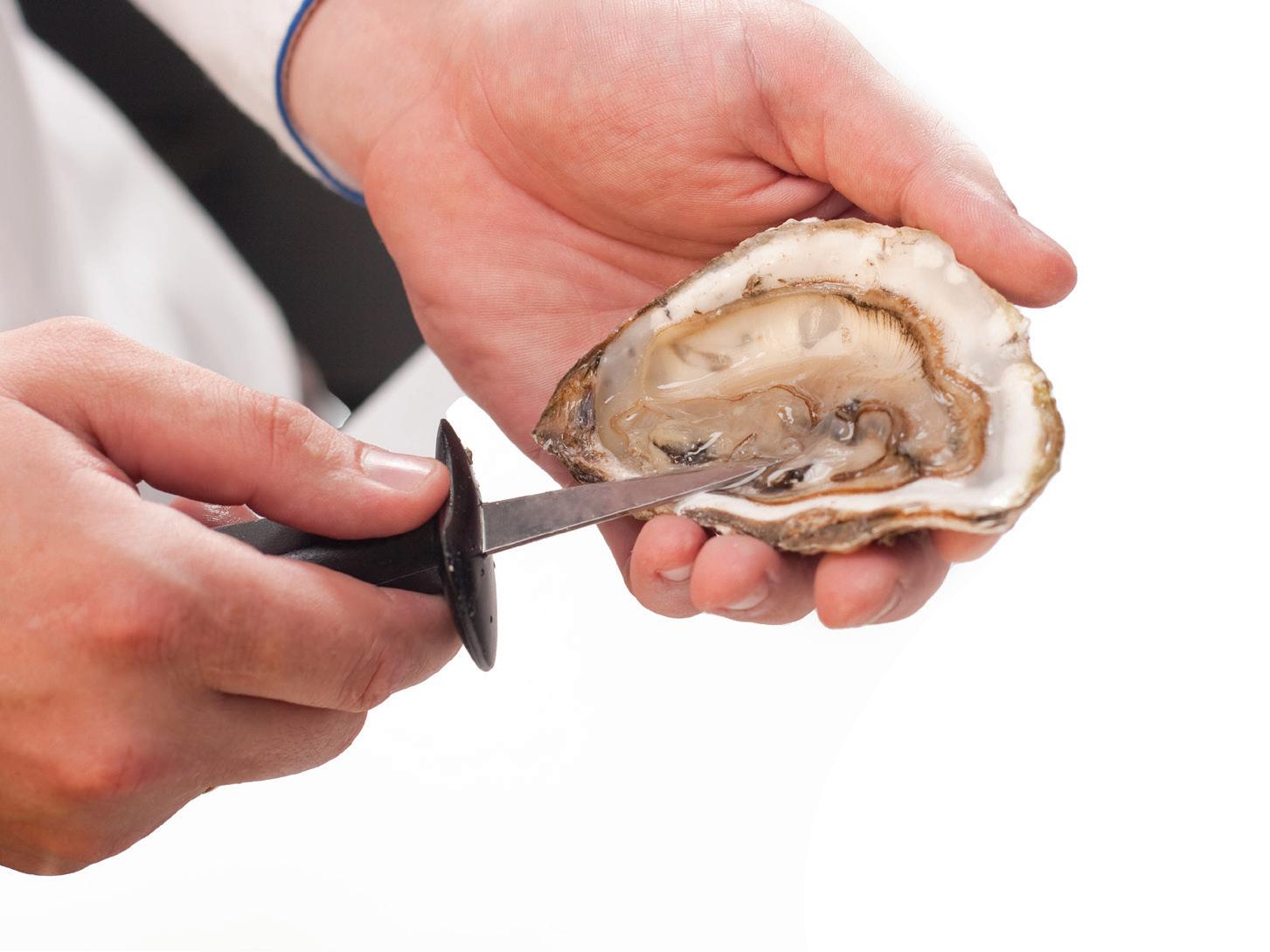
“Focus pressure on the hinge, and using an up-anddown motion with the knife, pop the oyster open, being careful not to puncture the meat,” he writes. “Wipe the blade off and, from the back, shimmy the knife to open the shell a little while sliding it to the front. Peek in the oyster and locate the adductor ‘eye’ and scrape the shell to cut it loose from the top shell. Repeat the same maneuver on the bottom shell.”
If you’re a visual learner, check out Toups’ cookbook for a stepby-step photo guide.
In 2015, the National Institutes of Health retired chimpanzees used in research centers throughout the United States. The private nonprofit Chimp Haven outside Shreveport took them in, becoming the world’s largest chimpanzee sanctuary. The refuge hosts more than 300 chimpanzees in 200 forested acres. The public may view the animals in their relaxing habitat, and learn about the animals closest biologically to humans, on Chimpanzee Discovery Days held on two Saturdays every year. Tours are available upon request. chimphaven.org
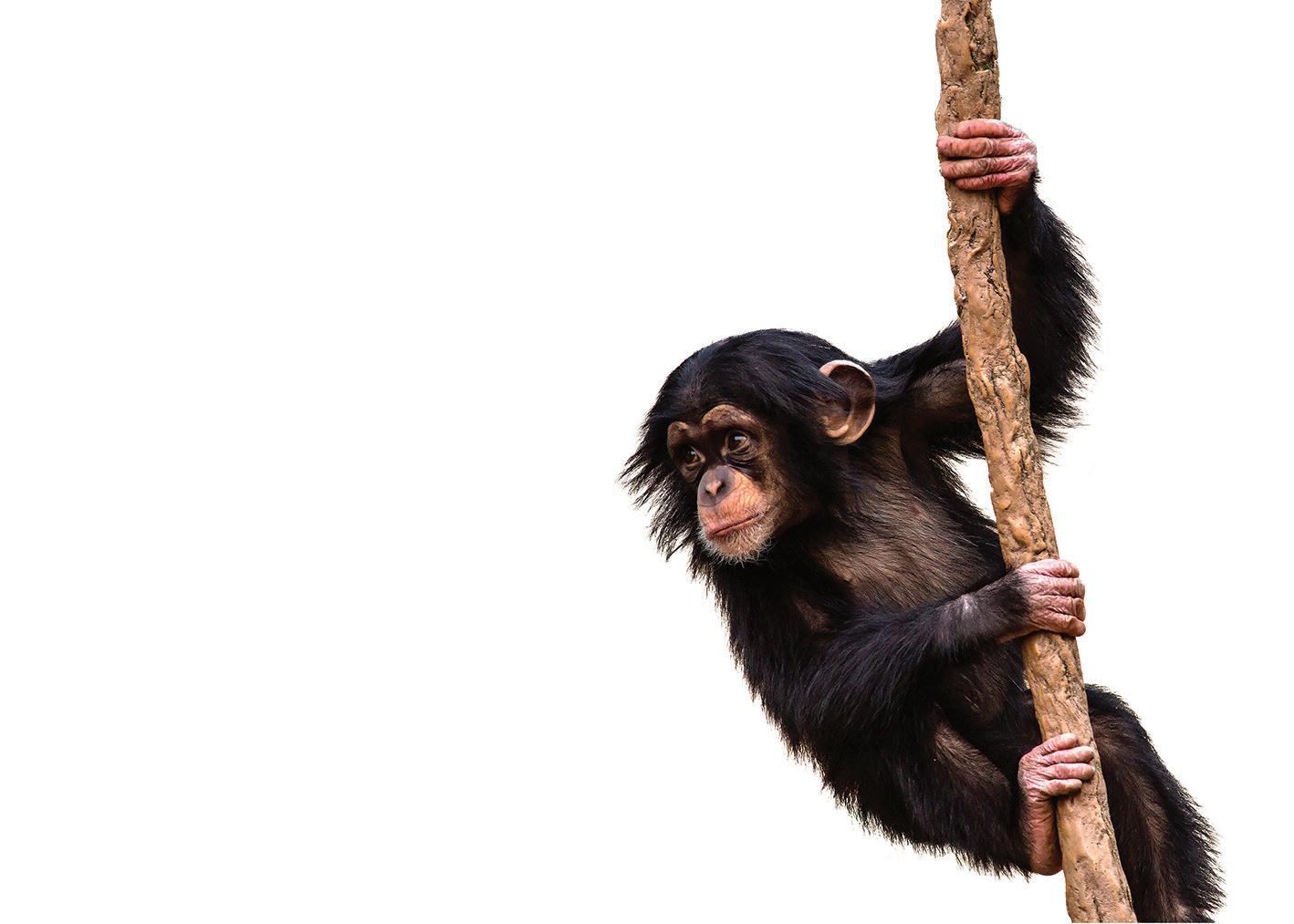
This legends hails from France, where loup-garou means a man who transforms into a wolf. Cajun tales take on new attributes, such as the creature inhabiting swamps. Louisianians often tell their children the loup-garou or rougarou singles out misbehaving kids. Hey, it works. For fun around this legend, don a costume and enjoy Houma’s Rougarou Fest in October. rougaroufest.org
There are simple ways to make a roux — add oil (or butter) to a skillet, whisk in flour, blend well and then stir until you achieve the right color. Just don’t let it burn. For gumbo, stock, meat and seafood are added depending on the type desired. According to Chef John Folse, who wrote “The Encyclopedia of Cajun & Creole Cuisine,” a conventional French roux to use in gumbo includes 1 cup of oil and flour with 6-12 cups of stock, with “10 cups stock to a perfect Louisiana gumbo consistency.” ¶ For those who lack patience, try Cajun Power gumbos (add your meat or seafood) or gumbo starters such as Zatarain’s, Tony Cachere’s or Louisiana.
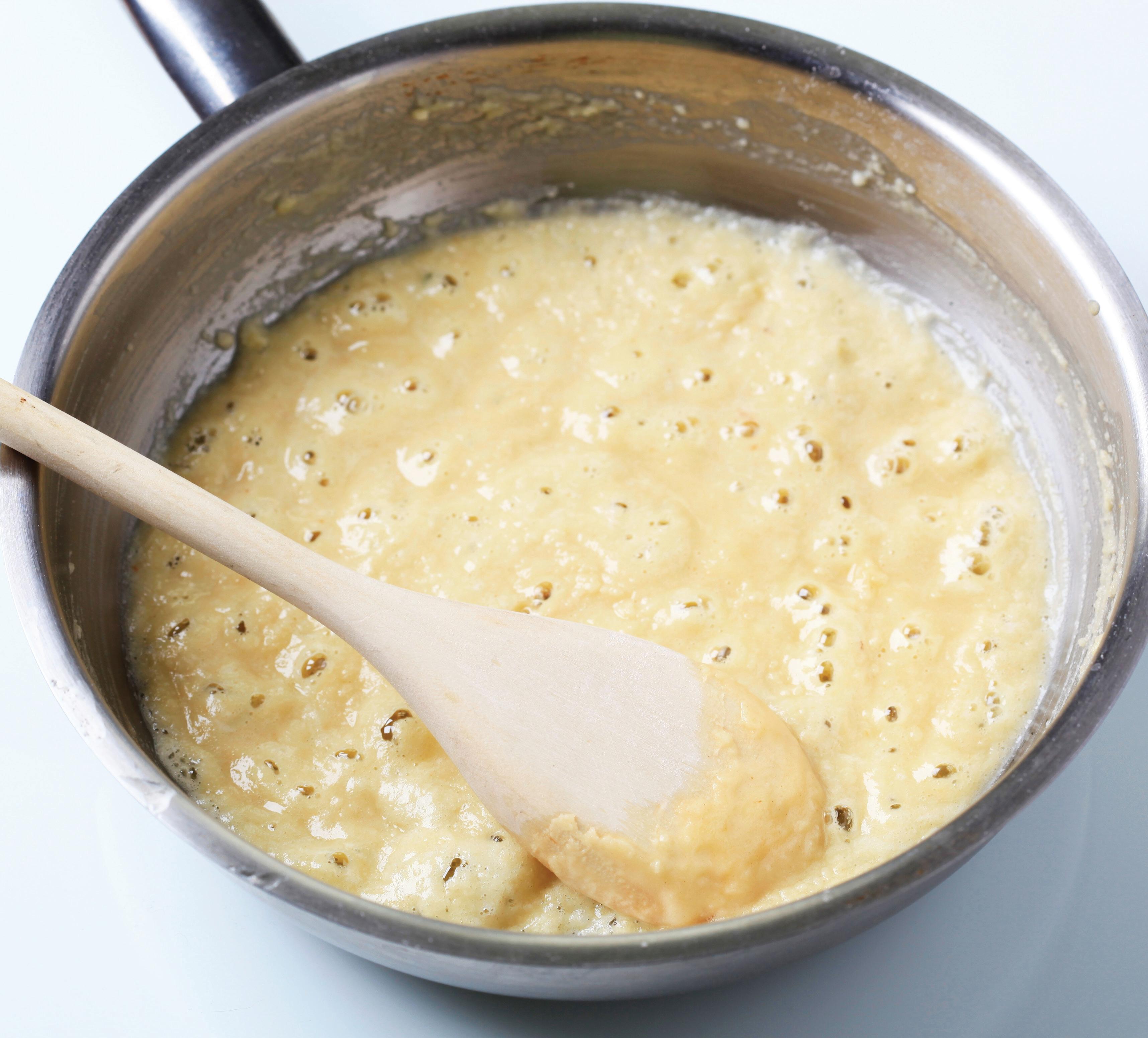
Baton Rouge owns two unique state capitols: the Old State Capitol, a colorful castle-like structure that Mark Twain called “pathetic” that’s now revered and the 34-story New State Capitol, a premiere example of art deco architecture that was built in record time for only $5 million in 1932. ¶ A visit to both in the Capital City is a must, said Tamaria Williams, communications manager for Visit Baton Rouge. ¶ “View the town from the 27th floor observation deck of the New State Capitol,” said Williams. “And the Old State Capitol — there’s no other building like it.” ¶ Don’t miss the bullet holes on the ground floor of the New State Capitol, the site where Sen. Huey P. Long was fatally shot in 1935.
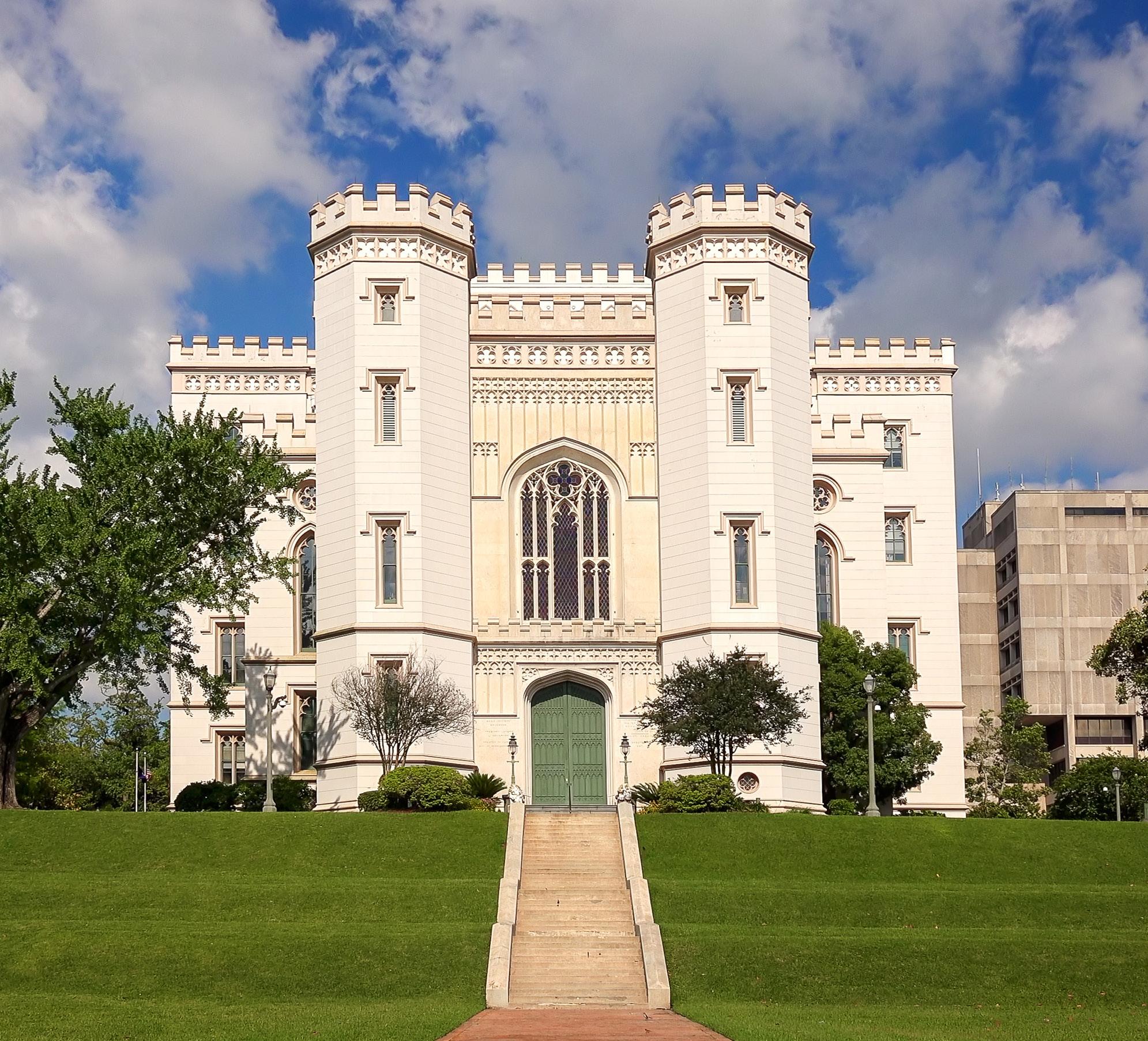
Many cities, streams and streets have French, Spanish and Native American names but that’s doesn’t mean they’re pronounced correctly. The New Orleans street of Burgundy, for instance, is written like the wine, but pronounced “Brrr-gun-dee.” New Orleanians call Caliope, one of the “Muses” streets, “Cal-ee-op.”
Over in Cajun Country, locals chose a happier rendition for the city named for the Marquis de Lafayette, hero of the American Revolution. It’s Laffy-ette, not La-Fie-Ette. Port Barre and Boutte appear as if there might be an accent acute on the end but it’s Port Bar-ee and Bou-T.
Here are a few others that routinely stump tourists and new residents:
Atchafalaya: At-chaff–a-lie-a
Tchoupitoulas: Chop–a–tool-as
Prytania: Pry–tan-ee–a
Ouachita: Wash-it-taw
Apparitions love our state and refuse to check out of hotels, remind us of past murders as is the case of The Myrtles Plantation and offer fodder for TV shows, such as the French Quarter’s LaLaurie Mansion. There are too many tales to relay here, but ghost tours and books abound to offer a good scare.

They may look like small lobsters, but their cooking and eating require a different mindset. ¶ First, fill a pot of water enough to cover your collection of live crawfish and add your favorite seafood boil to the mix. When the water boils, add the crawfish and cover. After the water boils again, wait about two to three minutes, then turn off the heat. Let the crawfish simmer about 15 minutes in the pot, adding desired seasoning. Pour the crawfish on to a table lined with newspaper and enjoy. ¶ Louisianians will tell you it’s not a crawfish boil unless you add lagniappe, meaning a little something extra such as onions, potatoes, corn — you decide! ¶ To peel a crawfish, grab the head with one hand and tail with the other, twisting the tail from the head. Peel off the first two to three rings of the shell from the tail meat, pinch the end of the tail and pull the meat from the shell. If you dare — and most of us natives do — suck the juices and fat from the head.
“A Lesson Before Dying” There are so many wonderful novels by Ernest J. Gaines to choose from, but one of his most acclaimed novel remains “A Lesson Before Dying,” which won the National Book Critics Circle Award for fiction and was made into a HBO film.
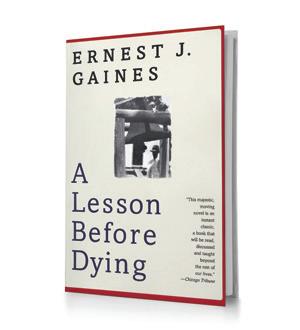
“The Awakening” Kate Chopin’s 1899 novel set in New Orleans and Grand Isle follows a woman and her unorthodox views on society and her role as a woman. It is considered by some as one of the earliest American feminist novels.

“The Moviegoer” Like John Kennedy Toole, Walker Percy’s debut novel details New Orleans in a more realistic light. The story revolves around Jack “Binx” Bolling in the post-World War II era who feels alienated from life. The novel won the National Book Award in 1962.

Louisiana is home to one of the most recognized brands in the world and visitors can learn how Tabasco is made with a visit to Avery Island, a short drive outside New Iberia. A tour of the Tabasco factory is a must, but additional options include lunch at Restaurant 1868!, a Tabasco cooking demonstration or a culinary course which includes, of course, the famous hot sauce. But there’s more! The Tabasco factory sits on a salt dome which appears above the environment as an island in the wetlands. Called Avery Island, Tabasco founders developed the unique land mass into the elaborate Jungle Gardens that’s open for either a self-guided driving tour or a guided bird tour of the egret sanctuary.
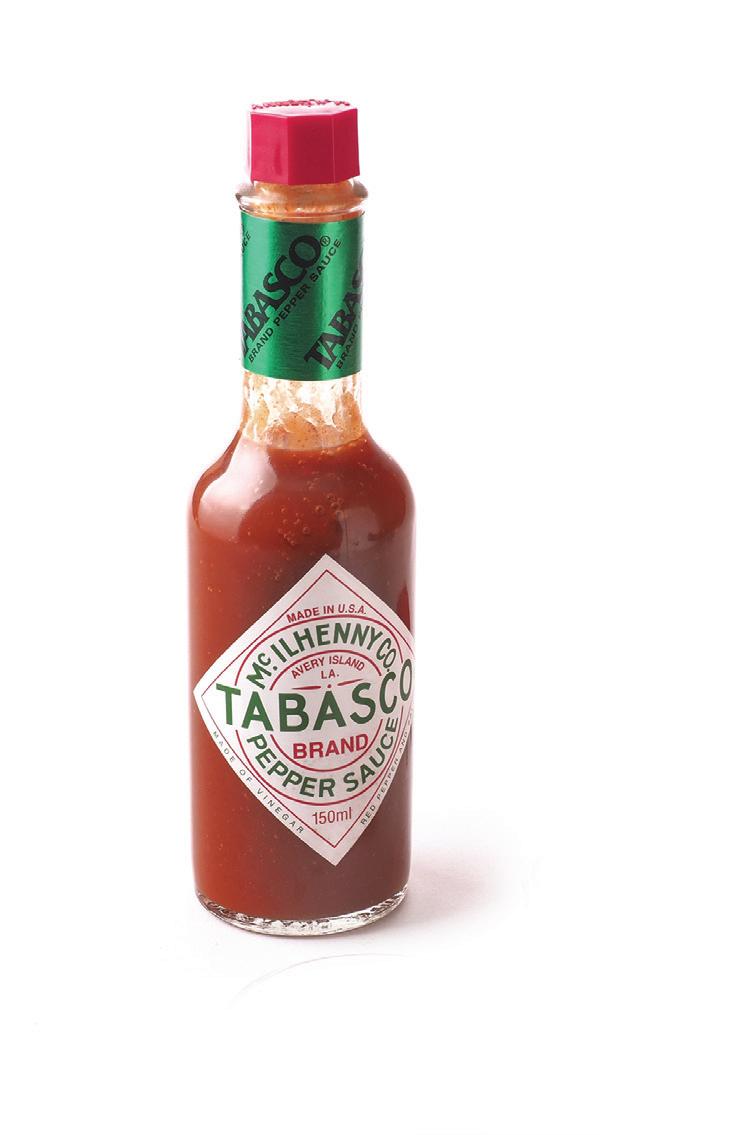
Cajuns were Acadians who settled the Maritime Provinces of Canada and were expelled by the British beginning in 1755. Many made their way to Louisiana and settled in parishes outside New Orleans. Their nickname, a shorter version of Acadian, was pronounced in French “Cad-jen.” Americans heard “Cajun” and it stuck. If you visit Nova Scotia and environs, the French citizens who remained there are still called Acadians. ¶ As for Creole, the question will undoubtedly elicit debate, mainly because there are many beliefs: of African American descent, mixed race and even white New Orleans residents. For the most part, Creoles are residents of a land with ancestral ties to other countries, mainly Europe and Africa. ¶ “It’s a contested term,” claims Elista Istre, author of “Creoles of South Louisiana: Three Centuries Strong,” adding that she bases Louisiana Creole on three things: who you talk to, the time period and the location. ¶ As for cuisines, Creole cuisine refers to New Orleans while Cajun describes the dishes from the South Louisiana parishes known as Cajun Country.
This creature who lives in the wetlands near Slidell is Louisiana’s version of Bigfoot. Like Sasquatch, many have professed to viewing the hulking ape-like animal.
Our hero, hoagie, submarine sandwiches are called po’ boys and they come dressed, which means with mayo, lettuce and tomato and sometimes pickles. We cook with the “Holy Trinity”: onions, bell peppers and celery. Add garlic to the mix and it’s the “Four Seasons.”
When Americans bought Louisiana the established French and Spanish citizens weren’t too happy to see them, but they met on the median of Canal Street to do business, which is why we call medians in New Orleans “neutral grounds.” And it’s not relegated to Canal Street. For instance, the neutral ground on St. Charles Avenue is a great spot for Carnival parades.
Counties are parishes here — and Louisiana is the only state in the union to use the word.
Greetings are unique as well: “Ça va?” in Cajun Country and “Where y’at?” in New Orleans. Both mean, “How y’all doing?”
New Orleans sits in a massive crescent of the Mississippi River so no doubt the founders got a little confused. The “West Bank” is south of the city, east of Old Jefferson, but actually west in the Carrollton section of Uptown. Speaking of Uptown, that means up river while Downtown is downstream. Forget directions north and south, it’s riverside or lakeside.
URBAN LEGENDSFirst and foremost, Carnival is the season that begins on Jan. 6, otherwise known as 12th Night or the Epiphany, and runs to Mardi Gras day. Mardi Gras is the Tuesday before Ash Wednesday, the day we live it up to give it up. ¶ Don’t raise your shirt for beads. Save that indiscretion for the tourists. You’ll catch plenty without showing nudity. ¶ Don’t buy beads either. See previous advice. ¶ Do get to the parades early. The closer you arrive to the start time of the parade, the heavier the traffic and finding a good parking spot. ¶ Do be conscious of those who live on the parade route. You wouldn’t want people defacing your lawn. ¶ Don’t cross the street during a parade. This may seem like a no-brainer but people are injured every year trying to beat the oncoming floats and trucks. ¶ Do wear a costume on the big day, aka Mardi Gras. It’s a long-standing tradition and it’s fun for both the wearers and the observers.


Rachel Wellons seems happiest in clinic, where she balances work with students, patients and research. A board-certified clinical specialist, Wellons focuses on neurological physical therapy, with a specialty in vestibular rehabilitation.
The clinic is small but packed with equipment including weights and machines, a harness system, treadmills, a force plate technology device and infrared goggles. Here, Wellons treats patients and teaches the roughly 35 students she has each semester.
Passionate about the field of physical therapy and the benefits of rehabilitation, Wellons draws on years of experience and education. After receiving her Doctor of Physical Therapy degree from Thomas Jefferson University in 2006, becoming board certified in neurologic physical therapy and later attending the APTA Vestibular Rehabilitation course, Wellons came to LSU Health Sciences Center in 2011. She is an associate professor of physical therapy and online educational coordinator and chair for the Vestibular Special Interest Group of the Academy of Neurologic Physical Therapy.
By Reine Dugas Portrait by Adrienne Battistelladinate balance. Today, many people struggle with dizziness and balance issues.
“You can do physical therapy for dizziness — dizziness is not normal, and we have very good treatment for it,” Wellons said.
When Wellons diagnoses patients with vestibular dysfunction, she makes a careful analysis of eye movement to pinpoint the issue. She generally sees vestibular patients once a week and then gives them a comprehensive program to work on at home.
One of her recent patients was struggling with dizziness, and through the use of infrared goggles and specific maneuvers, Wellons diagnosed the problem and identified how to treat it.
Wellons explained, “Naturally occurring crystals in our ears become loose and move into the semi-circular canals where they aren’t supposed to be; there, they interfere with the flow of fluid and make people feel dizzy.”
Wellons first became interested in physical therapy in high school, where she was an athlete, injured her knee and needed physical therapy. Always strong in science, Wellons decided to go to physical therapy school, seeking a career where she could be around athletes. But all that changed one day.
“While I was in physical therapy school, I started learning about the brain,” Wellons said, “and I was hooked. So I switched from wanting to do sports to focusing on neurological therapy.”
She became particularly intrigued with vestibular rehabilitation in her senior year of school, when she did an independent study project on the differential diagnosis of dizziness.
Today, her research and practice focus on clinical translational research and vestibular rehabilitation. Vestibular rehabilitation is physical therapy for the inner ear — for dizziness and balance disorders.
The vestibular system is responsible for sensing movement and helps people balance. It sends signals to the eyes to coordinate eye and head movement and information to the neck and spine to coor-
After identifying the location of the crystals, Wellons took the patient through a series of different positions to migrate the crystals back to where they were supposed to be. After two series of maneuvers, the patient had no more dizziness.
Wellons cares about giving her patients the best treatment possible and training students to become effective physical therapists. She explains how important it is to find a good physical therapist.
“A good physical therapist will act as a coach, set you up on a program and help to motivate and adjust your program to your needs,” Wellons said. “Your physical therapist should listen to your needs, educate you on what to expect, when the results should come and what to look for as signs you’re getting better. A good physical therapist should always have a hypothesis about what might be wrong and should objectively measure progress toward your goal — and communicate that with you.”
“The role of the physical therapist,” Wellons said, “is to help patients move better so they can do the things they need and love to do. I’m the happiest when my patients are out there having fun. Getting patients to do all the activities they want to do and live their lives — that’s the biggest reward for me.”
Dr. Rachel Wellons helps patients live fuller lives by gaining relief from neurological challenges

THERE IS ONE MAJOR SOURCE that provides credible ongoing analysis of hospitals: Medicare, which, as the federal health insurance program for people 65 and older, as well as certain younger people with disabilities, often provides funding for many of the big bills. As part of its informational services, medicare.gov reports on evaluations of hospitals based on queries of patients. The Louisiana Life editorial staff sifts through the data every year in order to create a one-of-a-kind list that demonstrates the state’s hospitals according to locality. To qualify for this list, at least 60 percent of the patients queried had to give the hospital a top overall ranking of 9 or 10 (on a scale from 0 [lowest] to 10 [highest]). These are the top general service hospitals as seen through the eyes of those who have experienced them firsthand — the patients. Note, however, that several hospitals in the state did not have any information available on Medicare’s website and therefore could not qualify to be on the list.

ABBEVILLE
Abbeville General Hospital
118 N. Hospital Drive (337) 893-5466
ALEXANDRIA
Christus Central Louisiana
Surgical Hospital
651 North Bolton Ave. (318) 449-6400
Christus St. Frances Cabrini Hospital
3330 Masonic Drive (318) 487-1122
Rapides Regional Medical Center
211 4th St. (318) 769-3000
BASTROP
Morehouse General Hospital
323 W. Walnut (318) 283-3600
BATON ROUGE
Baton Rouge General Medical
8585 Picardy Ave. (225) 387-7767
Ochsner Medical Center-Baton Rouge
17000 Medical Center Drive (225) 752-2470
Our Lady of the Lake Regional Medical Center
5000 Hennessy Blvd. (225) 765-6565
Surgical Specialty Center of Baton Rouge
8080 Bluebonnet Blvd. (225) 408-8080
The Spine Hospital of Louisiana 10105 Park Row Circle, Suite 250 (225) 763-9900
Womans Hospital
100 Woman’s Way (225) 927-1300
BOGALUSA
Our Lady of the Angels Hospital
433 Plaza St. (985) 730-6700
BREAUX BRIDGE
Ochsner St Martin Hospital
210 Champagne Blvd. (337) 332-2178
BUNKIE
Bunkie General Hospital
427 Evergreen St. (318) 346-6681
CHALMETTE
St. Bernard Parish Hospital
8000 West Judge Perez Drive (504) 826-9500
COLUMBIA
Caldwell Memorial Hospital Inc.
441 Main St. (318) 649-6111
Citizens Medical Center 7939 U.S. Hwy. South (318) 649-6106
COVINGTON
Avala 67252 Industry Lane (985) 801-3010
St. Tammany Parish Hospital 1202 S. Tyler St. (985) 898-4000
CROWLEY
Acadia General Hospital
1305 Crowley Rayne Hwy. (337) 783-3222
DELHI
Richland Parish Hospital
407 Cincinnati St. (318) 878-5171
DERIDDER
Beauregard Memorial Hospital
600 S. Pine St. (337) 462-7100
EUNICE
Acadian Medical Center 3501 Hwy. 190 (337) 580-7903
FARMERVILLE
Union General Hospital
901 James Ave. (318) 368-9751
FORT POLK
Bayne-Jones ACH
1585 3rd Street Fort Polk (337) 531-3118
FRANKLIN
Franklin Foundation Hospital
1097 Northwest Blvd. (337) 828-0760
FRANKLINTON
Riverside Medical Center
1900 South Main St. (985) 795-4431
HAMMOND
Cypress Pointe Surgical Hospital
42570 South Airport Road (985) 510-6200
North Oaks Medical Center 15790 Paul Vega MD Drive (985) 345-2700
HOMER
Claiborne Memorial Medical Center
620 East College St. (318) 927-2024
HOUMA
Leonard J. Chabert Medical Center 1978 Industrial Blvd. (985) 873-2200
Physicians Medical Center 218 Corporate Drive (985) 853-1390
Terrebonne General Health System
8166 Main St. Houma, LA 70360 (985) 873-4141
INDEPENDENCE
Lallie Kemp Medical Center 52579 Highway 51 South (985) 878-9421
JENA
Lasalle General Hospital 187 Ninth St. (318) 992-9200
JENNINGS
Ochsner American Legion Hospital 1634 Elton Road (337) 616-7000
JONESBORO
Jackson Parish Hospital 165 Beech Springs Road (318) 259-4435
KAPLAN
Abrom Kaplam Memorial 1310 W. Seventh St. (337) 643-8300
KENNER
Ochsner Medical Center-Kenner 180 W. Esplanade Ave. (504) 464-8065
KINDER
Allen Parish Hospital 108 6th Ave. (337) 738-2527
LAFAYETTE
Lafayette Surgical Specialty Hospital
1101 Kaliste Saloom Road (337) 769-4100
Ochsner Lafayette General Medical Center 1214 Coolidge Ave. (337) 289-7991
Ochsner University Hospital and Clinics
2390 West Congress (337) 261-6000
Our Lady of Lourdes Regional Medical Center, Inc 4801 Ambassador Caffery Parkway (337) 470-2100
Park Place Surgical Hospital 4811 Ambassador Caffery Parkway (337) 237-8119
LAKE CHARLES
Christus Ochsner Lake Area Hospital 4200 Nelson Road (337) 474-6370
Lake Charles Memorial Hospital 1701 Oak Park Blvd. (337) 494-3000
LAKE PROVIDENCE
East Carroll Parish Hospital 336 North Hood St. (318) 559-4023
LEESVILLE
Byrd Regional Hospital
1020 Fertitta Blvd. (337) 239-9041
LULING
St. Charles Parish Hospital
1057 Paul Maillard Road (985) 785-3644
LUTCHER
St. James Parish Hospital
1645 Lutcher Ave. (225) 869-5512
MAMOU
Savoy Medical Center 801 Poinciana Ave. (337) 468-5261
MANSFIELD
Desoto Regional Health System 207 Jefferson St. (318) 872-4610
MANY
Sabine Medical Center 240 Highland Drive (318) 256-1232
MARRERO
West Jefferson Medical Center 1101 Medical Center Blvd. (504) 347-5511
METAIRIE
East Jefferson General Hospital 4200 Houma Blvd. (504) 454-4000
MINDEN
Minden Medical Center
No. 1 Medical Plaza (318) 377-2321
MONROE
Monroe Surgical Hospital 2408 Broadmoor Blvd. (318) 410-0002
Ochsner LSU Health Monroe 4864 Jackson St. (318) 330-7515
St. Francis Medical Center
309 Jackson St. (318) 966-4000
MORGAN CITY
Ochsner St. Mary 1125 Marguerite St. (985) 384-2200
NATCHITOCHES
Natchitoches Regional Medical Center
501 Keyser Ave. (318) 471-2628
NEW ORLEANS
New Orleans East Hospital 5620 Read Blvd. (504) 592-6600
Ochsner Clinic Foundation 1516 Jefferson Hwy. (504) 842-3000
Southeast Louisiana Veterans Health Care System 2400 Canal St. (800) 935-8387
Sterling Surgical Hospital 989 Robert Blvd. (504) 690-8200
Touro Infirmary 1401 Foucher St. (504) 897-8247
Tulane Medical Center 1415 Tulane Ave. (504) 988-5263
University Medical Center New Orleans 2000 Canal St. (504) 702-3000
OAKDALE
Oakdale Community Hospital 130 N. Hospital Drive (318) 335-3700
OAK GROVE
West Carroll Memorial Hospital 706 Ross St. (318) 428-3237
OPELOUSAS
Opelousas General Health System 539 East Prudhomme St. (337) 948-3011
PINEVILLE
Alexandria VA Medical Center 2495 Shreveport Hwy. 71 North (318) 473-0010
RACELAND
Ochsner St. Anne General Hospital
4608 Highway 1 (985) 537-8377
RAYVILLE
Richardson Medical Center
254 Highway 3048 (318) 728-4181
RUSTON
Northern Louisiana Medical Center 401 East Vaughn Ave. (318) 254-2100
SHREVEPORT
Christus Shreveport-Bossier Health System
1453 E. Bert Kouns Industrial Loop (318) 681-5000
Ochsner LSU Health Shreveport 1541 Kings Highway (318) 675-5000
Ochsner LSU Health Shreveport-St. Mary Medical Center
911 Margaret Place (318) 626-4300
Overton Brooks VA Medical Center 510 East Stoner Ave. (318) 424-6037
Specialists Hospital Shreveport 1500 Line Ave. (318) 213-3800
Willis Knighton Medical Center, Inc
2600 Greenwood Road (318) 212-4000
SLIDELL
Ochsner Medical CenterNorthshore, LLC 100 Medical Center Drive (985) 646-5000
Our Lady of the Lake Surgical Hospital
1700 W. Lindberg Drive (985) 641-0600
Slidell Memorial Hospital 1001 Gause Blvd. (985) 643-2200
SPRINGHILL
Springhill Medical Center 2001 Doctors Drive (318) 539-1000
SULPHUR
West Calcasieu Cameron Hospital 701 East Cypress St. (337) 527-7034
THIBODAUX
Thibodaux Regional Medical Center 602 N. Acadia Road (985) 447-5500
VILLE PLATTE
Mercy Regional Medical Center 800 E. Main (337) 363-5684
VIVIAN
North Caddo Medical Center 815 South Pine St. (318) 375-3235
WEST MONROE
Glenwood Regional Medical Center 503 McMillan Road (318) 329-4600
WINNFIELD
Winn Parish Medical Center 301 W. Boundary Ave. (318) 648-3000
WINNSBORO
Franklin Medical Center 2106 Loop Road (318) 435-9411
ZACHARY Lane Regional Medical Center 6300 Main St. (225) 658-4000
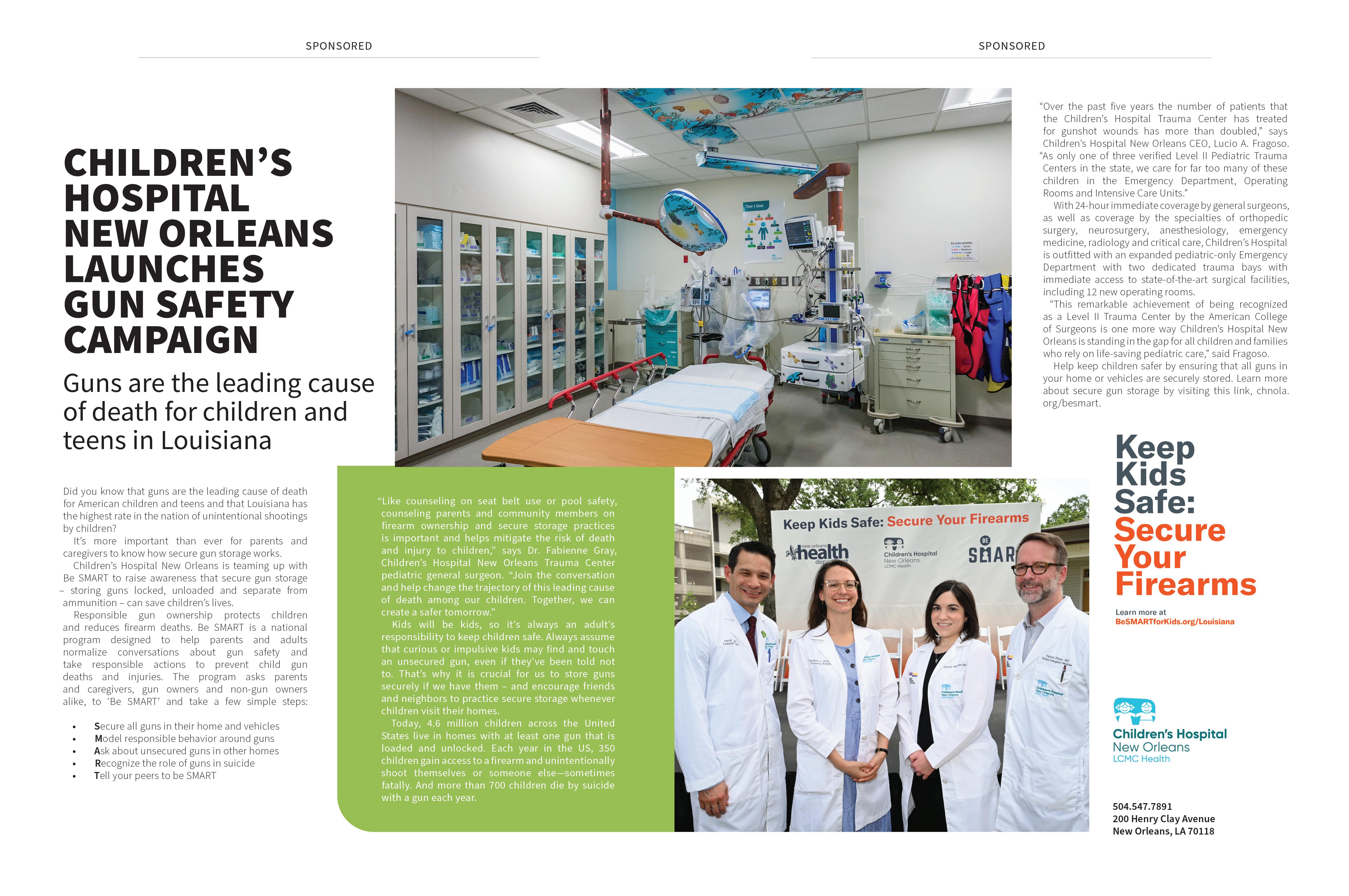

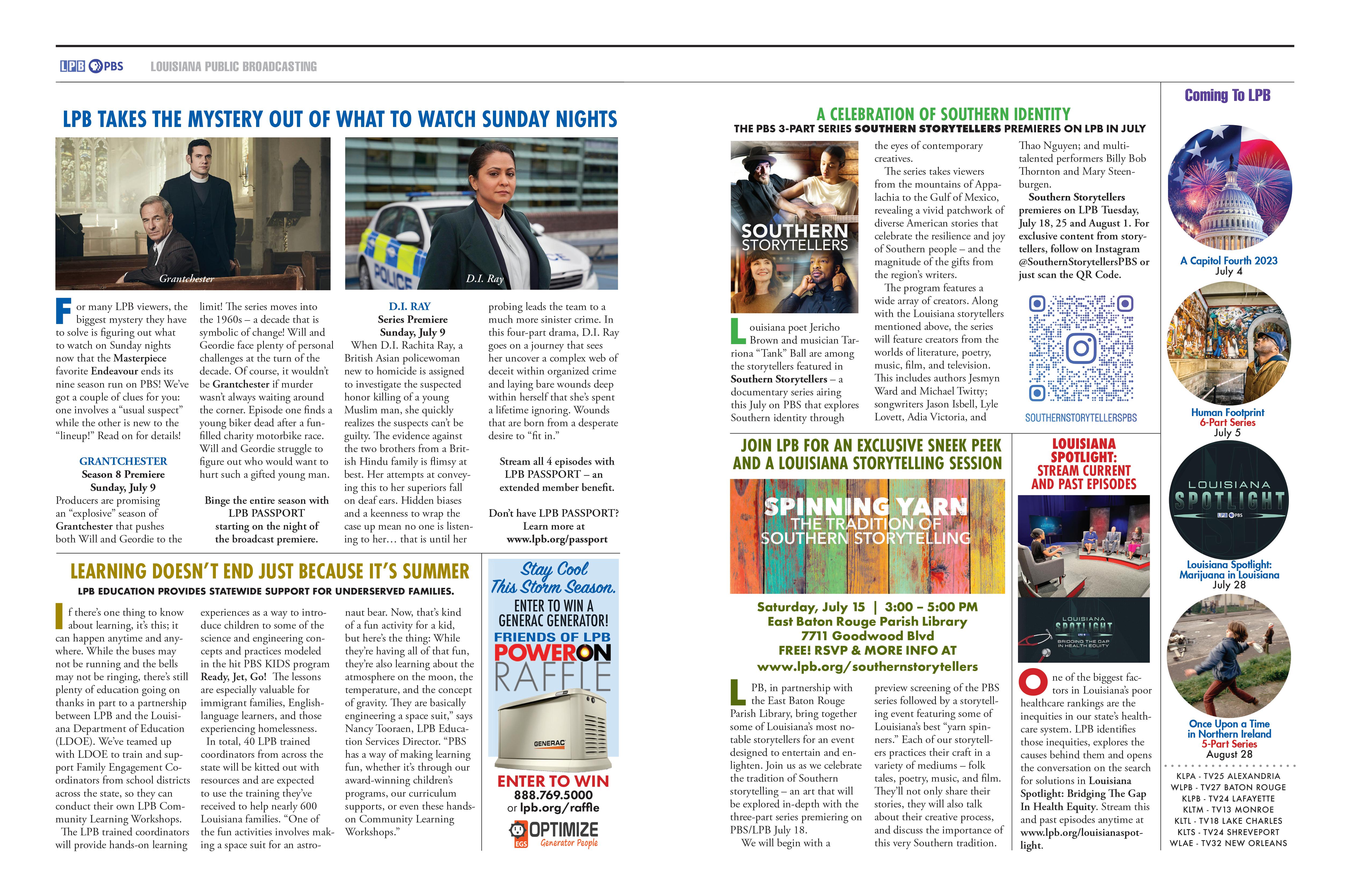

FFounded in 1714 and known for being Louisiana’s oldest city, Natchitoches’ rich history set the stage for the cultural city’s hereafter. Celebration on the Cane is a riveting event to look forward to in the area, and it’s to take place July 1st on the panoramic Cane River Lake. The event encompasses a phenomenal fireworks show at 9 pm, delicious food, and musical entertainment! Not too far to follow, the Louisiana Sports Hall of Fame Induction is to be held July 27th through the 29th.

This noteworthy event highlights and introduces the most deserving Louisiana athletes of 2023.
Famous for being home of the movie, Steel Magnolias, Natchitoches bestows the adored filming sites of this classic picture. Also beyond worth the gallivant is the fascinating plantations that each tell a story of their own. They include Melrose on the Cane with the art of Clementine Hunter and the Cane River Creole National Historical Park at Oakland Magnolia Plantations. To
plan your next trip, visit natchitoches.com.
Whether you enjoy fishing in Toledo Bend or watching living history reenactments of Civil War battlefield sites, unearthing DeSoto Parish is something everyone should relish in. Located on the Louisiana/Texas state line, DeSoto and all its beauty showcase some of the most alluring piney woods you’ll ever see on a scenic drive. Its rural charm is just one of many of the great things the lovely area has to offer.
If you’re looking to experience the region, Balloons Over DeSoto taking place July 16th is the perfect chance to view the area! It’s a free event for families to get together and enjoy air balloon rides, live entertainment, delicious food, a car show, and a fireworks show! Mansfield State Historic Site maintains over 175 acres of Civil War battlefield where the Battle of Mansfield took place. Visitors can absorb the site through the research library, museum, gift shop, picnic area, and much more. Discover DeSoto’s unique history and woodsy feel at discoverdesoto.com
Home of Louisiana’s Old State Capitol and all things Louisiana State University, Baton Rouge exudes all that Louisiana is about. Originally built in 1847, the iconic Old State Capitol holds such rich history that boasts the stories of Louisiana’s 1800s through 1900s. Anyone from children to adults are guaranteed to enjoy their visit whether you’re there to learn about Huey P. Long or just to take in its decadent design. Make sure to include a visit to the awe-inspiring Louisiana State Capitol building, proudly standing as the tallest capitol in the entire country.
Calling all art and science enthusiasts to explore the Louisiana Art & Science Museum! The museum houses a large and diverse range of exhibits that incorporate engaging learning programs, artwork that leaves you in awe, and interactive displays. Small children would take more than just a liking at the Knock Knock Children’s Museum. The institution is meant for little ones to “learn through play” by exploring 18 different learning zones!
Other beloved Baton Rouge mustvisits are Mike the Tiger’s Habitat and the countless delicious restaurants in the region that will leave you wanting more. To learn more about all that Baton Rouge has to offer, go to visitbatonrouge.com.
Take a visit to the soulful and multicultural Shreveport-Bossier , located in northern Louisiana, where they are gearing up for the most captivating experience. The Red River Balloon Rally Festival, scheduled for July 14th and 15th, will feature hot air balloons of all kinds at Louisiana Downs Casino & Racetrack. This memorable event offers a plethora of attractions, including AEP Swepco kid zones and sky-high tethered balloon rides for those seeking a bird’s-eye view of the festival!

As the sun sets, the balloons illuminate the night sky creating a mesmerizing view that is dazzling to attendees of all ages. Along with this magical balloon glow, enjoy live entertainment, delicious food, and
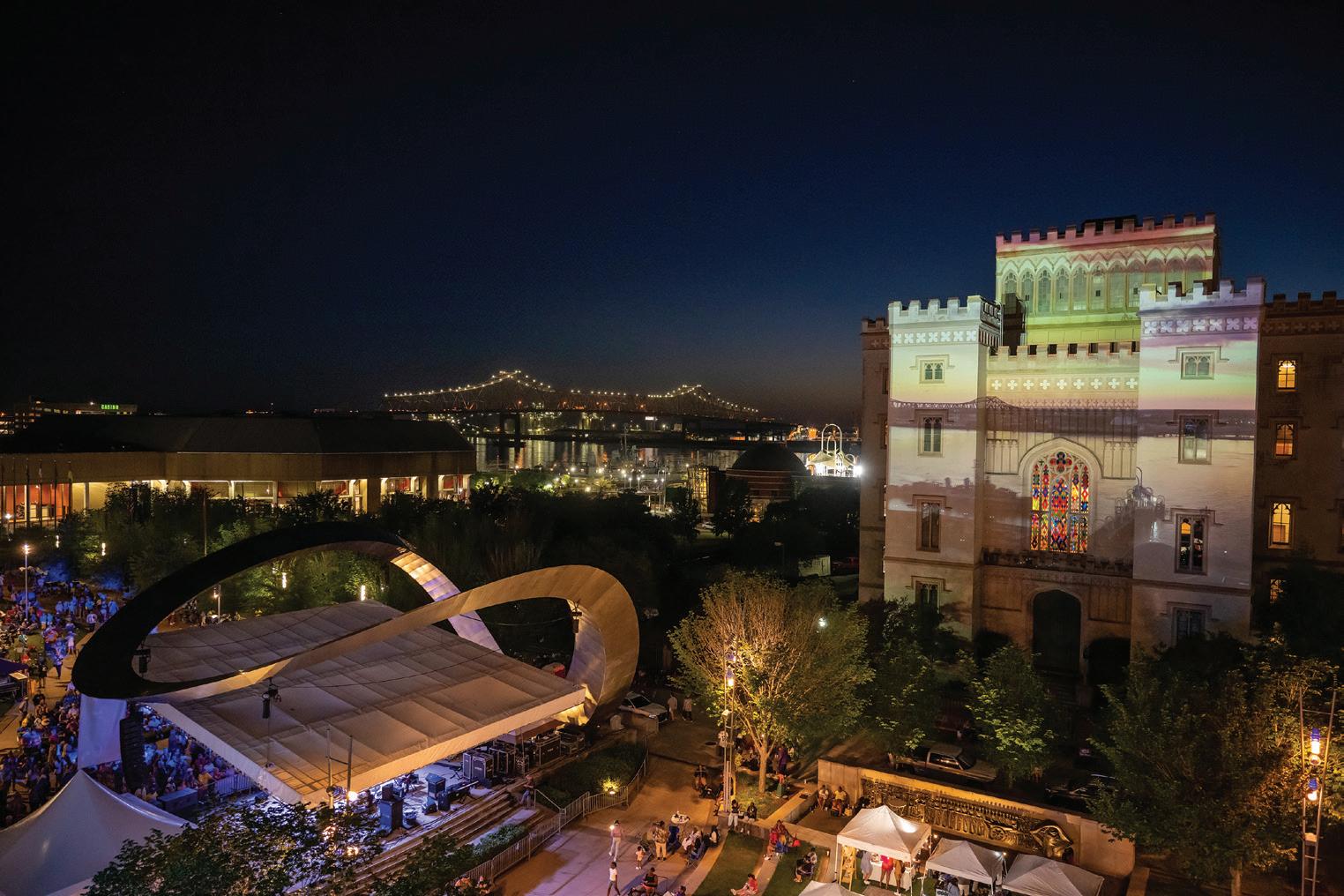
unique retail vendors that will only add to this unforgettable experience.
In addition, art enthusiasts won’t want to miss the Red River Revel Arts Festival, scheduled to take place September 30th through October 8th. This delightful event will showcase a diverse group of artistic talent, enjoyable for visitors with all tastes and interests! To learn more about these upcoming events and others, go to visitshreveportbossier.org.
The Helis Foundation , a Louisiana private foundation established and funded by the William Helis Family in 1955, is committed to the mission of advancing access to the arts in New Orleans for all. Through various initiatives from largescale murals to the South’s largest rotating sculpture exhibition, there is so much to see and do. The Helis Foundation’s Art for All program also provides access to New Orleans’ rich cultural heritage by underwriting free admission for all Louisiana residents at leading local institutions including the New Orleans Museum of Art, Contemporary Arts Center, New Orleans Botanical Garden, Ogden Southern Museum of Art, and the Louisiana Children’s Museum on select days throughout the year. As an extension of this program, during Louisiana’s infamously hot summer days, Art & A/C focuses on free admission for Louisiana residents every Saturday in August at several of these same institutions. So come indulge your inner art lover and enjoy the cool luxury of staying fresh indoors by visiting thehelisfoundation.org. n
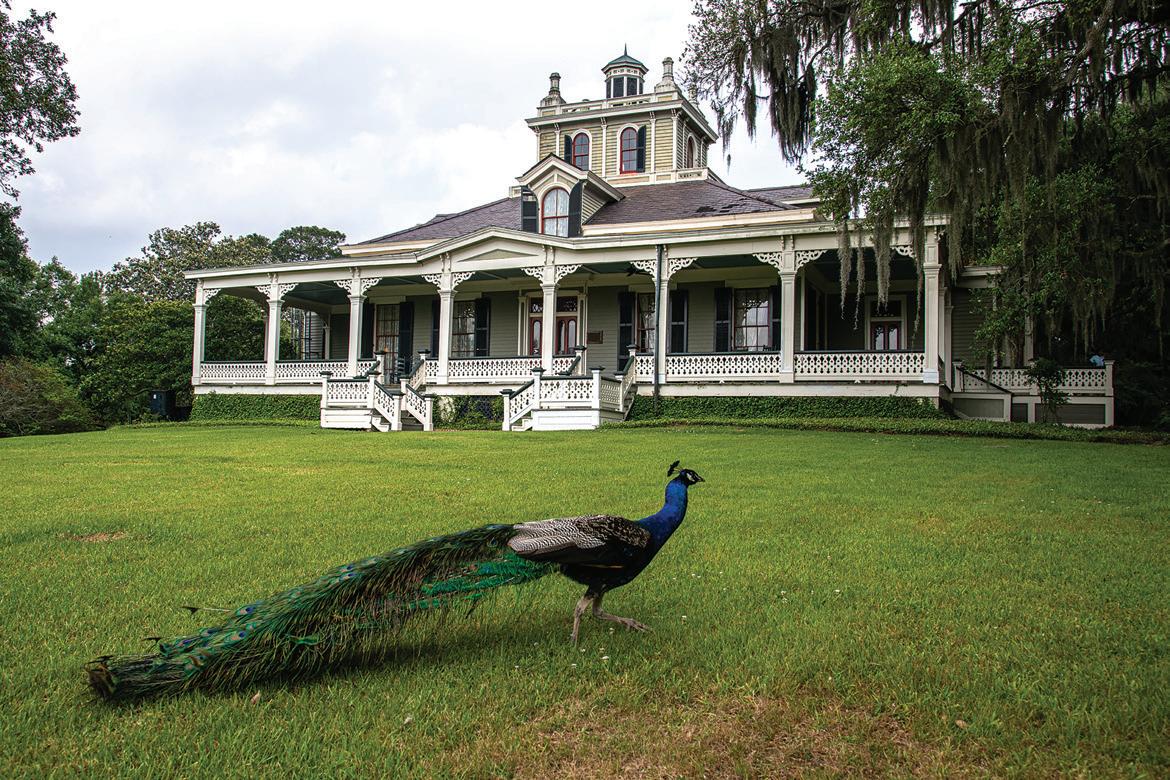 STORY AND PHOTOS BY KEVIN RABALAIS
STORY AND PHOTOS BY KEVIN RABALAIS
Jefferson Island. Nov. 20, 1980. 5:45 a.m.
A rhythmic shaking jolted her awake. Fifteen minutes later, during their daily jog, Vickie Richard told her brother, Mike Richard, about the experience. Strange, they both agreed, but it was still dark, and details about the day’s work at Rip Van Winkle Gardens demanded their immediate attention. Now, more than 40 years later, Mike Richard, who began his horticultural apprenticeship at the gardens in 1969 and has worked here ever since, stares at the brick chimney that rises from Lake Peigneur. It’s all that remains of the house, long since burned, where the gardens’ previous owners lived.
“The catastrophe broke the earth,” Richard says of that day when the house sank 30 feet from its original elevation.
At 7 a.m., he felt the garden grounds rumble for the first time. “There was a lot of glass in the new reception center,” says Richard, president of Live Oak Gardens Ltd., which, since 2003, has owned Rip Van Winkle Gardens. That glass now trembled. For a minute, it ceased before the earth pulsed once again. This cycle continued in intervals throughout the morning.
Two hours later, the superintendent of Diamond Crystal Salt Company rushed in to inform Richard that a Texaco oil rig had accidentally punctured the salt mine beneath Lake Peigneur. By then, the oil rig had vanished beneath the lake’s surface. Richard gestures to the last place he saw it, 43 years ago. “Employees were running to their cars,” he says. “People thought the whole place was going to sink.”
Fifty-two miners remained stuck underground, some as deep as 1,800 feet. Water flooded into the mine. The superintendent feared they would all be trapped. He floated the idea of evacuating the entire island — immediately.


All 52 miners eventually surfaced safely. The oil rig, along with one other, never emerged. The mine never reopened. In the aftermath, Richard realized that Rip Van Winkle Gardens faced a new challenge: groundwater quality had changed drastically. Four decades later, it’s still a daily complication.
“A week after the catastrophe, we noticed that certain plants had turned as yellow as orange juice,” he says. Historically, water has flowed here from the Chicot aquifer. The breach in the salt mine shifted water flow.
Now contaminated, that water carried more minerals, among them calcium, magnesium and iron carbonates.
To save Rip Van Winkle Gardens, Richard constructed four ponds, each at different elevations and consisting of different habitats. Water moves from pond to pond to aerate and eliminate iron carbonate. From the fourth and deepest pond, the water returns to the nursery. “We started to see the benefits right away,” Richard says.
As part of his never-ending work to keep the gardens alive and beautiful, Richard also built a rookery between

two of the ponds. Today it’s aflutter with great egrets, roseate spoonbills and great American herons. Smiling, he points to another of the pond’s residents. “Alligators are enforcers,” he says. For this reason, Richard refuses to cull them. “What they provide is kind of like an extortion. They say, ‘We’re going to take care of the snakes and coons.’ They keep the rookery thriving.”
After the catastrophe, Richard learned that the government maintained two seismic recording stations within seven miles of Jefferson Island. The stations triangu-

lated the salt mine puncture to 5:45 a.m., the moment that Vickie Richard felt the first tremor. Later still, Mike Richard and his 4-year-old son, Mike Jr., were walking beside Lake Peigneur. Below, Richard Sr. thought he spotted a rock or stone tool and asked his son to get it. Richard Jr. grasped it and looked toward his father. “It’s a tooth,” he said. The event that swallowed two oil rigs had unearthed a mastodon.
They soon found more remnants: a jawbone, a tusk, more teeth. Eventually, they uncovered two more mastodons. Richard Jr. later attended school for paleontology. Now he manages Live Oak Gardens Wholesale Nursery on Jefferson Island. Richard’s daughter, Michelle, manages Rip Van Winkle Gardens. His wife, Louise, developed the recipes and menus at Café Jefferson, which overlooks Lake Peigneur. “I’m technically retired,” Richard says, laughing. There’s always more work, and now it’s time to feed the gardens’ 24 peacocks. He knows many by name. n
Iberia Parish
FLORA
Rip Van Winkle Gardens consists of approximately 15 acres of semitropical gardens that include irises, magnolias, camellias, azaleas, hibiscus, and springtime bulbs.

FAUNA
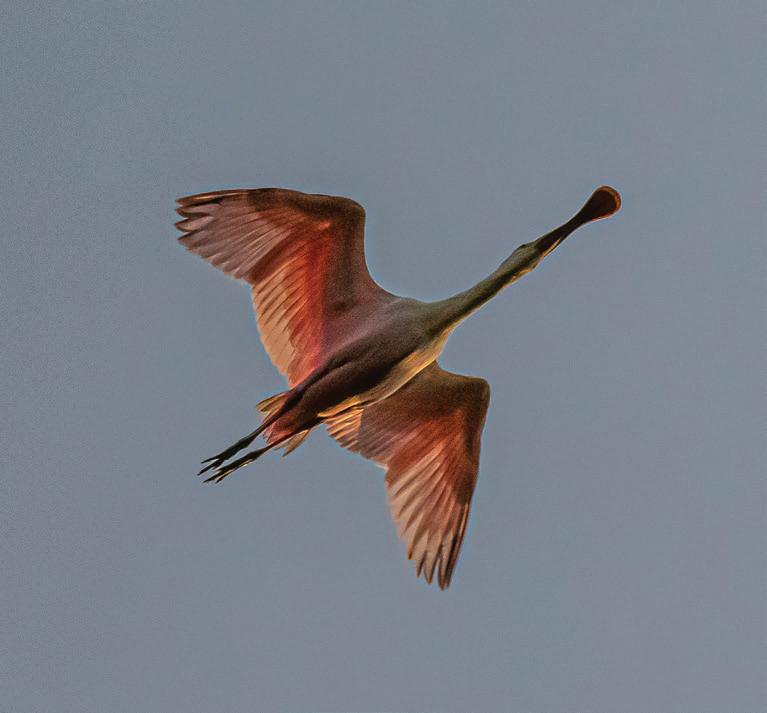
The grounds of Rip Van Winkle Gardens include a schoolhouse built in the 1930s for the salt mining community. It now serves as a home for birds — including macaws, cockatoos, and African grey parrots — whose owners have died.
FUN FACT
Philadelphia-born actor Joseph Jefferson (1829-1905) toured the world performing his most famous role, Washington Irving’s character Rip Van Winkle. “And like Rip, he was beloved, as beloved as Bob Hope or Jack Benny,” writes Arthur W. Bloom in “Joseph Jefferson: Dean of the American Theatre.” “His death ... made front-page national headlines.” Jefferson bought hunting property on land then known as Orange Island. On this property in 1870, he built a mansion, complete with a fourth-story cupola. The house, which is on the island now named after its owner, is listed on the National Register of Historic Places.
Toledo Bend’s list of attractions grows beyond its reputation for fishing, boating and golfing
BY CHERÉ COENIt’s easy promoting a region as bountiful to anglers as Toledo Bend, one of the top bass fishing lakes in the country. This year, however, Georgia Craven was besides herself, for the largest man-made body of water in the South and the fifth largest man-made reservoir in the United States is exploding with new attractions.
“I’m the happiest person on the planet,” said Craven, executive director of the Sabine Parish Tourist & Recreation Commission.
From the opening of a new water park to renovations and additions at two state parks and Cypress Bend Resort, there are plenty of reasons to visit Toledo Bend this summer.
Wildwood Resort has been attracting visitors to its expansive property filled with cabins, stocked fishing ponds, fishing pier and three swimming pools, to name a few of its amenities, but now there’s one more reason to visit. The owners opened Toledo Bend Family Adventure Park on Memorial Day Weekend, a water park featuring four slides, lazy river, splash pads, pools, a concession stand and an 18-hole mini golf course.
Visitors may stay in the cabins — or Wildwood’s new RV park — across the street from the water park and retreat to the original property for bird watching, fishing, stargazing around the fire pit or playing sports such as basketball. Wildwood’s a one-stop fun arena.
Golfers flock to Cypress Bend Resort for its golf course weaving over rare Louisiana hills, some veering close to the lake for beautiful vistas — with many times a bald eagle flying by. The course dates back 25 years, so
Tree stumps in the lake at Toledo Bend are one of the reasons the area has become a hot spot for fishing.

it needed renovation, Craven said. The resort staff has been busy remaking holes, thinning out forests for better lake views and renovating the club house. The new and improved course will open this fall.
“It is going to be by far the best golf course in the state,” Crave said. “The views from every hole is spectacular. It’s a golfer’s dream.”
The resort also renovated the pool and spa and will soon update its guest rooms, she added.
Toledo Bend hosts numerous fishing tournaments every year, including the Bassmaster Open Series, which returned in April after a pandemic hiatus. The Louisiana lake has hosted B.A.S.S. Master Open 17 times and was the first lake to rank No. 1 two years in a row on Bassmaster magazine’s 100 Best Bass Lakes list. So, we’re talking wicked good fishing. As of April, when we last spoke to Craven, 40 lunkers (large-scale bass) had been pulled from the lake.
“We have been on fire this year for fishing,” she said.

The lake’s special for fishing because when they dammed the Sabine River in the mid-20th century, the lake filled up quicker than engineers imagined, leaving live trees standing in the water. Today, those stumps within Toledo Bend may be dangerous to boaters but they prove great for fishing. Look for largemouth bass, bream, crappie (or as we say in Louisiana sac-au-lait), catfish and white and striped bass.
Folks at Living the Dream know the lake well and will prove it with their guided fishing services, one of many along the lake. But now, they have opened a marina on the Texas Highway where they not only launch their services, but visitors may rent pontoons and jet skis or enjoy a meal and drink while watching the sun set over Texas.
Close to Toledo Bend are the towns of Many and Zwolle, the latter known for its incredible tamales and the annual tamale festival in the fall. Many recently opened a new museum in its renovated train depot, showcasing local artwork on one side and history of No Man’s Land on the other. When the United States purchased Louisiana from France, its neighbor Spain (before it was Texas) disputed the boundary lines on its eastern border. Until map lines could be negotiated, the region surrounding the Sabine River held no governing body, hence the name No Man’s Land. That all changed with the 1819 Adams-Onis Treaty establishing the Sabine River as the boundary between Spain and the United States.
There are three state parks in the region: North Toledo Bend State Park near Zwolle and South Toledo Bend State Park at the lake’s south end and Fort Jessup State Historical Site heading toward Natchitoches. Both lakeside state parks have received facelifts over the past two years, including the thinning out of forests to bring in glamping tents, more hiking trails and the addition of a championship disc course in North Toledo Bend State Park. The state parks are also part of Louisiana’s Birding Trails for the lake attracts rare and migratory species and is home to several bald eagle nests. n
At first glance, walking across a suspension bridge above Gatlinburg, Tennessee didn’t raise my anxiety levels, but when kids moved past enjoying the rollicking motion of the bridge, my heart skipped a beat. When we hit the glass panels in the bridge’s center and I stared at my feet floating 140 feet above the ground, I wondered why I chose this adventure.
Gatlinburg SkyLift Park with its SkyBridge is one of many attractions in Gatlinburg and Pigeon Forge built for entertainment, some thrill-seeking. Both Tennessee towns are family adventures on steroids, attracting hundreds of people daily during the summer months.
But in the midst of my bridge fear, a bear sauntered by below and suddenly the Smoky Mountain experience lost its commercial appeal. The twin cities may be about fun, but underneath it all, we’re here for the mountains.
ORIGINS
The region dates to the 1700s, according to the Tennessee State Museum, but tourists began coming at the turn of the 20th century, drawn to the magic of the mountain range with its blue mist hanging low like smoke. Cherokee once called the mountains “Shaconage,” which meant “place of the blue smoke,” and from Clingmans Dome, the highest point in the Great Smoky Mountains National Park, it’s easy to see why.
Because of the beauty of the area, President Calvin Coolidge established the national park with land from North Carolina and Tennessee and money was raised for its inception. In the 1930s, President Franklin D. Roosevelt moved the Civilian Conservation Corps (CCC) to the area to build roads, bridges and campgrounds and the president opened the park in September 1940.
Today, the Great Smoky Mountain National Park is the most visited park in the United States. It spans 500,000 acres throughout the southeastern corner of Tennessee and the western edge of North Carolina and includes 850 miles of trails. It’s also a UNESCO World Heritage Site because of its five historic districts and nine buildings on the National Register of Historic Places.
Plus, the mountains are home to incredible diversity. “Diversity of stories, life and experiences,” said Dana
Downtown skyline of Gatlinburg, Tennessee
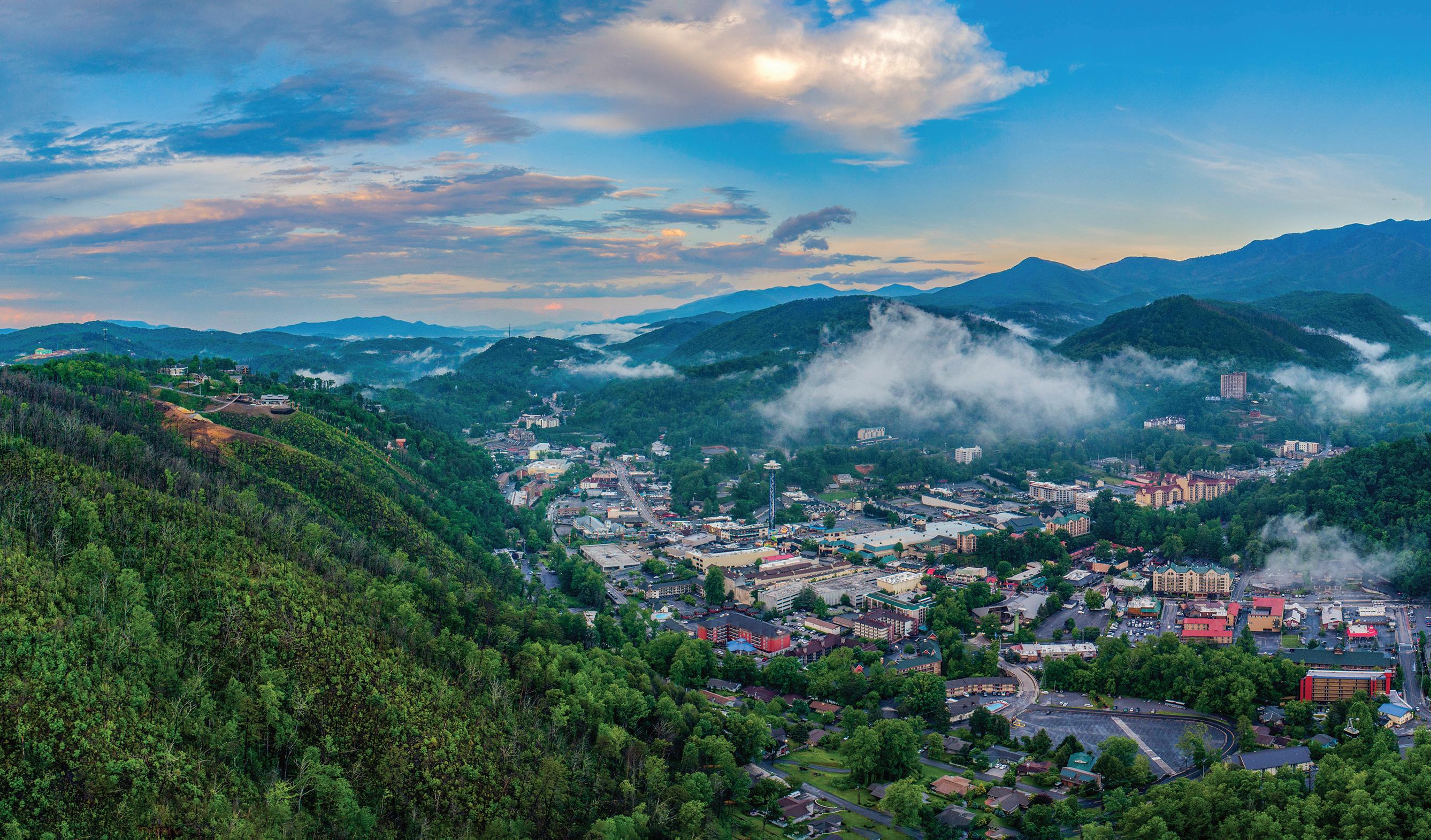
Soehn, the park’s management assistant for public affairs.

“In the park, you’ll discover the finest example of the ruggedness and scenic grandeur of the southern Appalachian Mountains, including 16 peaks over 6,000 feet and 70 miles of the Appalachian Trail,” she said. “You’ll also be immersed in one of the most biologically diverse areas in the temperate climate with over 20,000 different species of life — including 30 species of salamanders.”
Gatlinburg claims numerous attractions in addition to the SkyBridge. A ski lift takes visitors to Anakeesta high on a mountain overlooking the town with 72 acres of dining, shopping, ziplines, children’s adventure area, mountain coasters and, our favorite, the tree canopy walks. Ober Gatlinburg offers more of the same, available by sky tram, but also a wildlife encounter, indoor ice skating, ice bumper cars and more. For animal lovers of a different stripe, the Ripley’s Aquarium of the Smokies provides both viewing tanks and interactive exhibits.
Off the commercial main street visitors will find the largest independent organization of artisans in the country. The Great Smoky Arts & Crafts Community, formed in 1937, creates and sells original works in an 8-mile highway loop. In town, the Arrowmont School of Arts and Crafts offers a variety of classes in addition to its gallery and gift shop selling student wares.
Pigeon Forge bursts with attractions, everything from the Dolly Parton’s Stampede which provides a colorful horse show with a hearty dinner to the giant Ferris wheel and other breath-taking rides of The Island amusement park. The Titanic Museum looks at the 135 children who were aboard that fateful voyage with its “Year of the Titanic Children” exhibit and the Alcatraz East Crime Museum not only spotlights the criminals but the emergence of law enforcement agencies.
And, of course, there’s Dollywood.
Dollywood Parks and Resorts offers the centerpiece Dollywood theme park but also the 35-acre Splash Country filled with water rides shaded by trees. Visitors may stay at Dollywood’s DreamMore Resort and Spa or wait for the more upscale HeartSong Lodge & Resort scheduled for completion later this year.
New this year to the park is Big Bear Mountain, the park’s longest roller coaster to date and named for the mythical bear rumored to roam the area.
Above all, don’t miss why these towns emerged. The Great Smoky Mountains National Park is a national treasure and should be on everyone’s bucket list. Hike, camp or enjoy the interpretive centers but know that starting this year parking fees will be enforced, due to the high volume of tourists over the past few years. Parking rates are $5 a day or $15 for up to seven days. Entrance to the park is always free, thanks to its founders. Visit nps. gov/grsm for more information. n
 BY BRANDON WARE, SULPHUR
BY BRANDON WARE, SULPHUR

